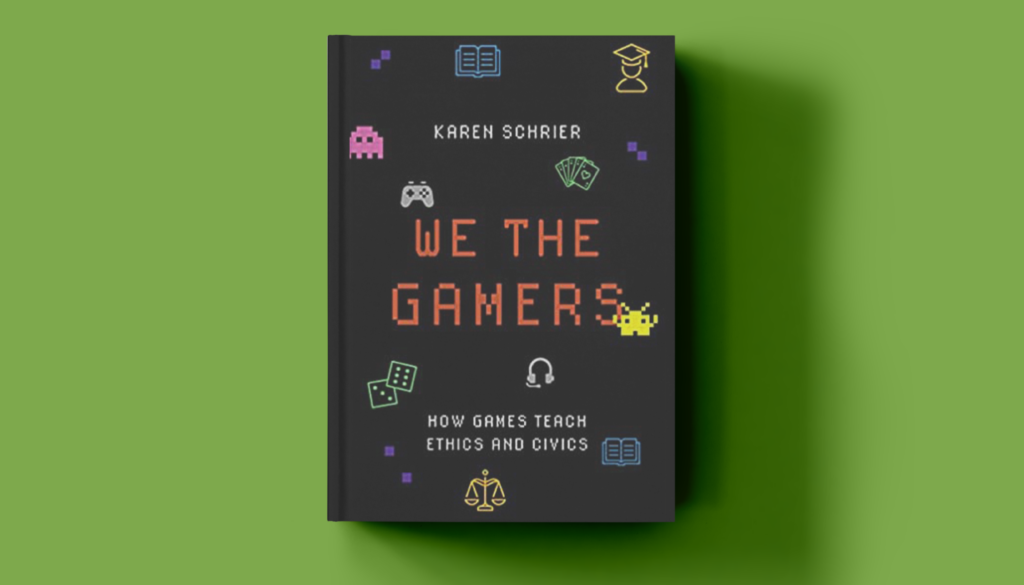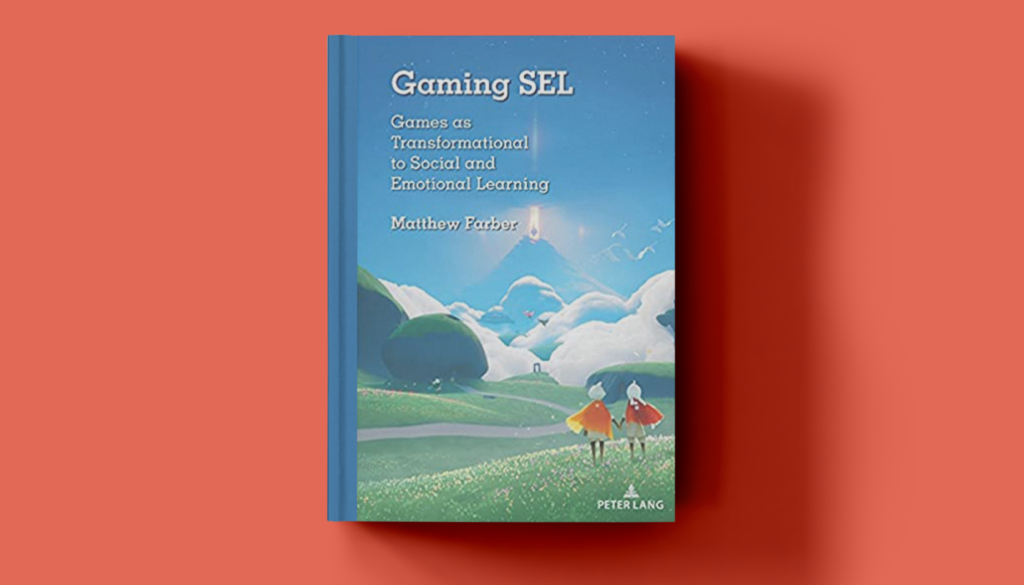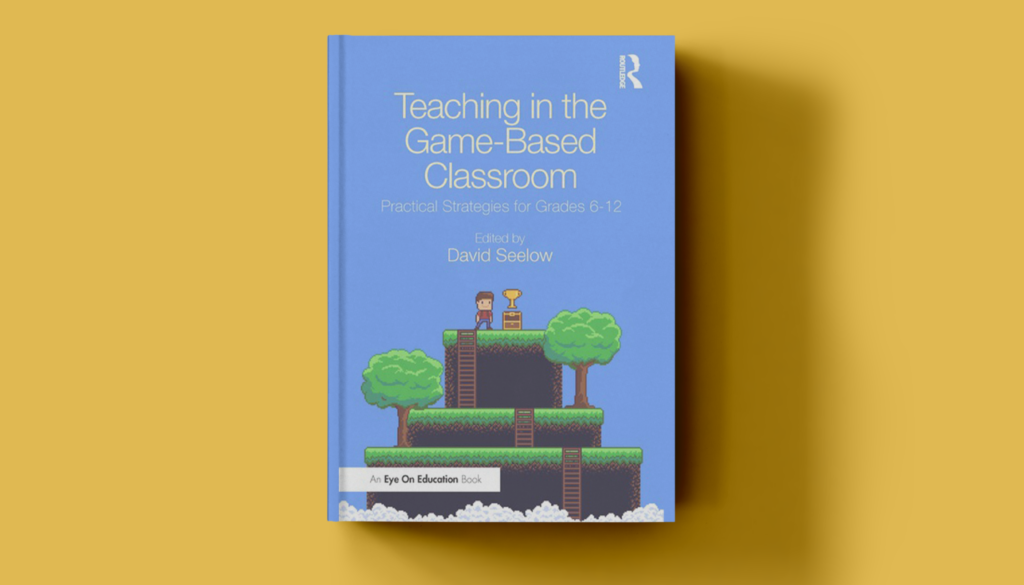Make It A Gameful School Year: Meeting Teens Where They Are With Play
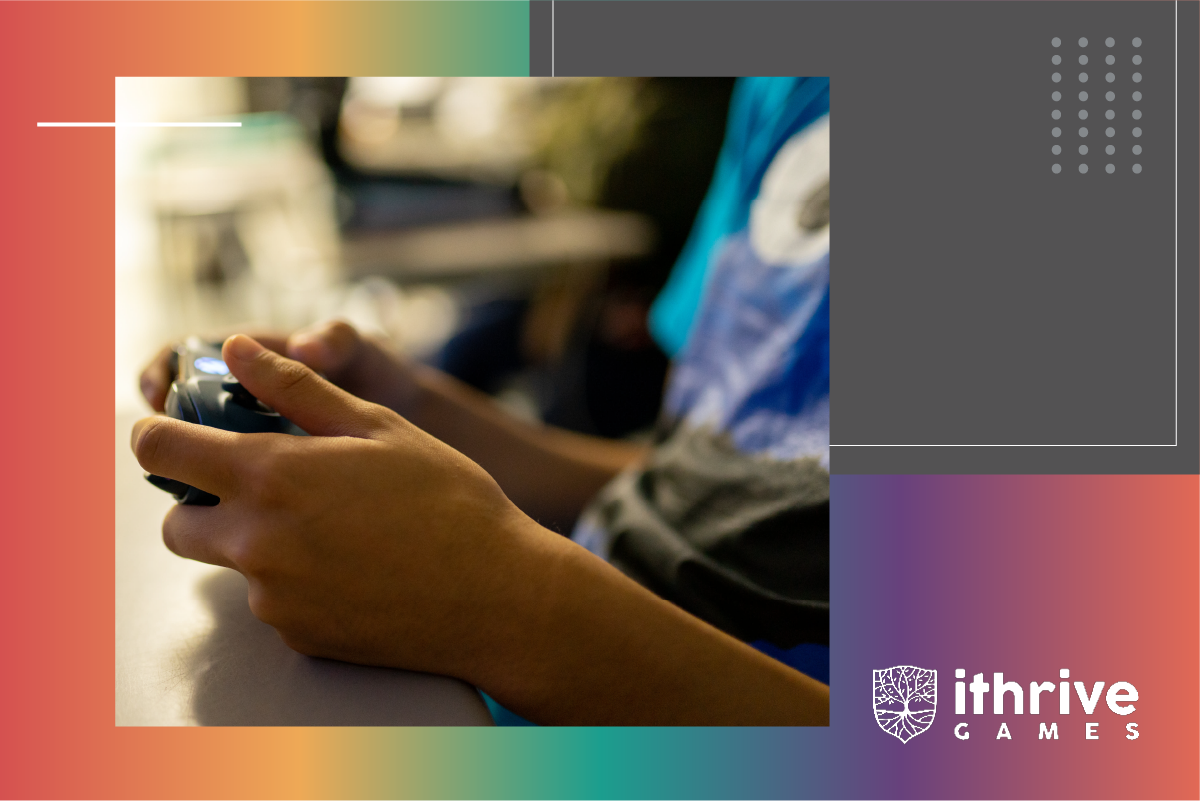
"I'm always going to enjoy a lesson where you can learn and have fun... It helps keep the students focused and even helps motivate them. I know I'm motivated to find out what happens next," shared a high school senior who, along with peers in his humanities class, was one of the first to gather around an Xbox One, play What Remains of Edith Finch, and meaningfully learn from it using our iThrive Curriculum unit, Museum of Me.
Games like What Remains of Edith Finch merge mechanics, worldbuilding, and challenges to deliver emotional and immersive experiences to all who play them. For the 85% of teens in the United States who play them (International Journal of Mental Health and Addiction), they are a solid and steady source of joy, connection, and entertainment.
At iThrive Games, we see the curiosity, embrace, and eagerness activated in teens by a never-before-seen start screen as a launchpad for social and emotional learning (SEL)—a transformative skill-building practice proven to protect and promote their mental health. Our team folds in what we know about the transcending and emotion-evoking power of games into a unique multidisciplinary, user-centered, and participatory approach that brings teens, researchers, game developers, and our adolescent development experts to the table to envision, create, and test tools that support teen thriving.
The games and game-based learning experiences we've co-designed alongside libraries, museums, schools, and youth-serving organizations we work with fully recruit the feelings conjured through play to create a wellness-supporting experience that centers teens' social and emotional needs. We use play to bring SEL to young people in a developmentally responsive way with games that invite them to uncover and nourish their strengths, craft and answer their own questions—activities that expand their understanding of themselves, others, and the world around them.
Beyond enthusiasts, we are ambassadors of play. Our team's first-hand witnessing of what games do (and can do) over the last five years has affirmed our belief in their unique capacity to support young people's thriving. We fully encourage educators, program coordinators, and all working with teens this school year to bring them into the spaces they share with them to see the power of play first-hand, too. Keep reading for resources, recommendations, and insights that support the integration of games in teen-serving settings and their use in teen-centered ways.
WHAT PLAY DOES (AND CAN DO) FOR TEENS
Play is beneficial for all of us, but for teens especially. Here are five things play does for young people, and can support, enable, and elevate when brought into the spaces where young people gather and learn:
Play activates deep learning and personal growth. Games present opportunities for teens to engage interactively and think expansively. Environmental storytelling coupled with mechanics that govern and guide the player's actions and the game's response to them give way to an experiential context where teens build knowledge while exercising personal agency—the conditions for deep, meaningful learning. "Games offer teens the ability to fully inhabit the world of a video game, to embody characters with agency along with the chance to impact the world and characters around them," shares Susan E. Rivers, PhD, iThrive's Executive Director & Chief Scientist. "They offer the agency and low-risk experimentation that teens rarely get but sorely need to discover who they want to be."
Play supports social and emotional development. Games make us feel. They delight us, challenge us, calm us, frustrate us, and excite us. They can prompt problem-solving, conflict resolution, and empathy, provoking opportunities that support teens' social and emotional learning. Social and emotional learning is defined by the Collaborative for Academic, Social, and Emotional Learning (CASEL) as "the process through which all young people and adults acquire and apply the knowledge, skills, and attitudes to develop healthy identities, manage emotions and achieve personal and collective goals, feel and show empathy for others, establish and maintain supportive relationships, and make responsible and caring decisions."
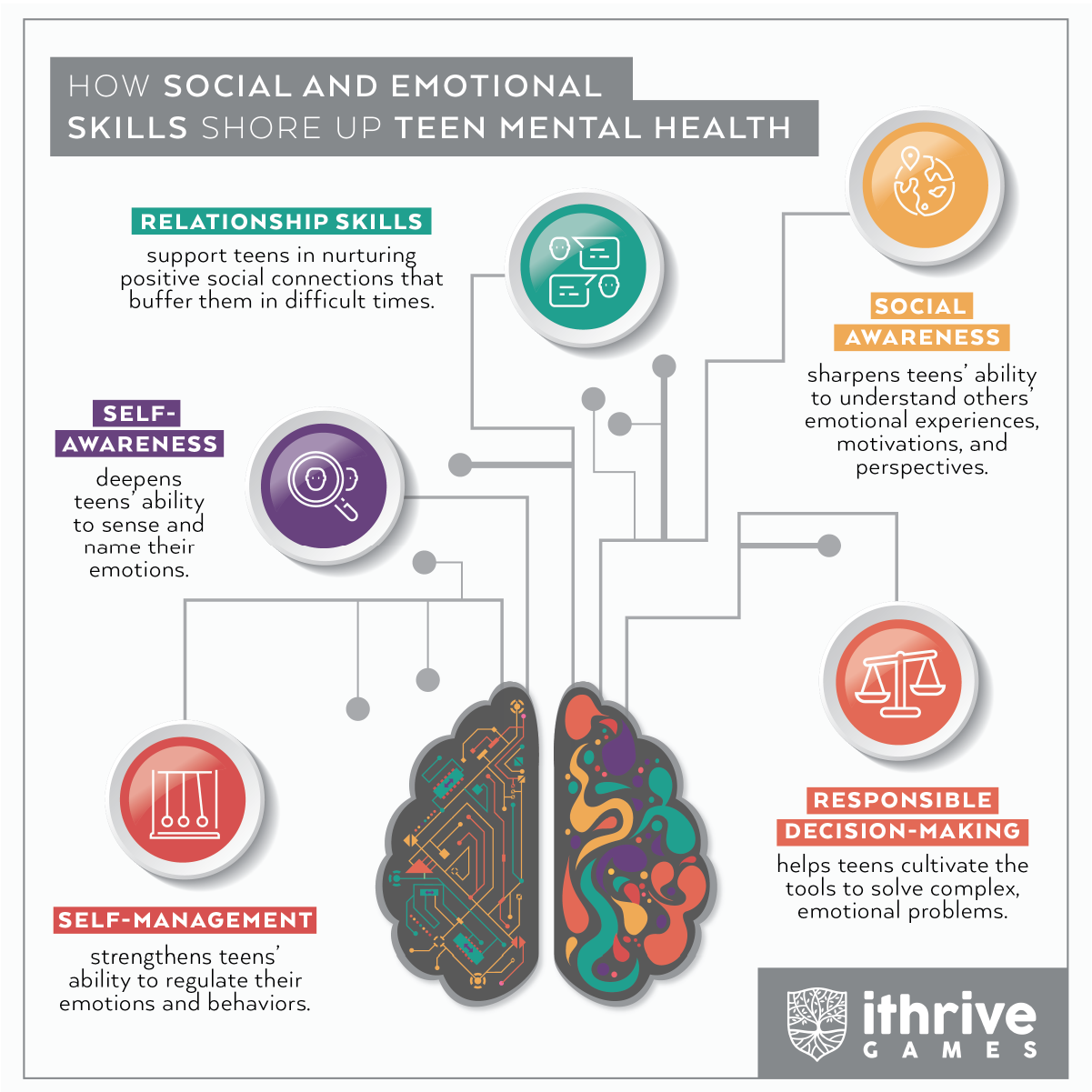
"How Social and Emotional Skills Shore Up Teen Mental Health." iThrive Games. https://tinyurl.com/what-sel-does-for-teens
Games provide a social space ripe with opportunities for young people to lean into these tasks, as well as developmental ones like identity exploration, establishing and exercising independence, and finding their place in community.
Play soothes. Games transport and immerse teens in new worlds, and with the space to interact as a new character and confront conquerable challenges comes the opportunity for stress reduction, self-gratification, and flow states. In countless co-design sessions with teens, we've heard that games are an outlet for relaxing and unwinding, providing a constructive space for coping, breaking for a bit, and pressing pause in challenging moments.
Play fosters connection. When teens play with peers, be it competition or collaboration, they socialize and connect, tasks paramount to their mental health. In the connective spaces games offer, teens can share their triumph and joy with others. They can work together toward a shared in-game goal and, sometimes, tackle the fallout of a shared loss in powerful bond-building experiences.
INTEGRATING PLAY WHEREVER TEENS LEARN AND GATHER
The work of adolescence has always been social and emotional, and young people need tools and strategies to help them navigate it. What games do for teens make them a useful means of support, and when enlisted by adults in their world as a medium of engagement, they are further solidified as valuable parts of young peoples' toolkits.
For all looking to leverage the power of play this school year while in community with teens, here are three ways to do so:
1. Pull in a game-based learning curriculum, or create your own.
Game-based learning supports educators in using the power of games to define and support their students' learning outcomes. When lesson plans leverage video games—an entry point familiar to most teens—they pave the way for a culturally responsive learning experience supportive of innovative thinking, deep learning, and in the case of our standards-aligned iThrive Curriculum units, A Moment in Time, Museum of Me, and Sam's Journey) that center themes relevant to teens like navigating identity exploration, relationships, and social media, their social and emotional development too. For educators who value accessibility also, game-based learning aligns with Universal Design for Learning principles. As a stark differentiation from traditional learning approaches, games help educators reach and engage teens with a practice that acknowledges that teens are vast and wonderful, engaging with concepts from different access points. Here's how to choose a video game for a high school humanities or English class and a case example of how iThrive Games does so.
2. Employ role-playing simulations to support a 'learn by doing' approach.
Role-playing simulations engage teens in a high-energy experience with hands-on learning as they are challenged to strategize and act. Multiplayer ones, particularly, invite them to interact and investigate with each other and pursue shared goals. The embodied learning accompanying the role-playing propels their curiosity and motivation to explore possibilities transferable to real-life contexts.
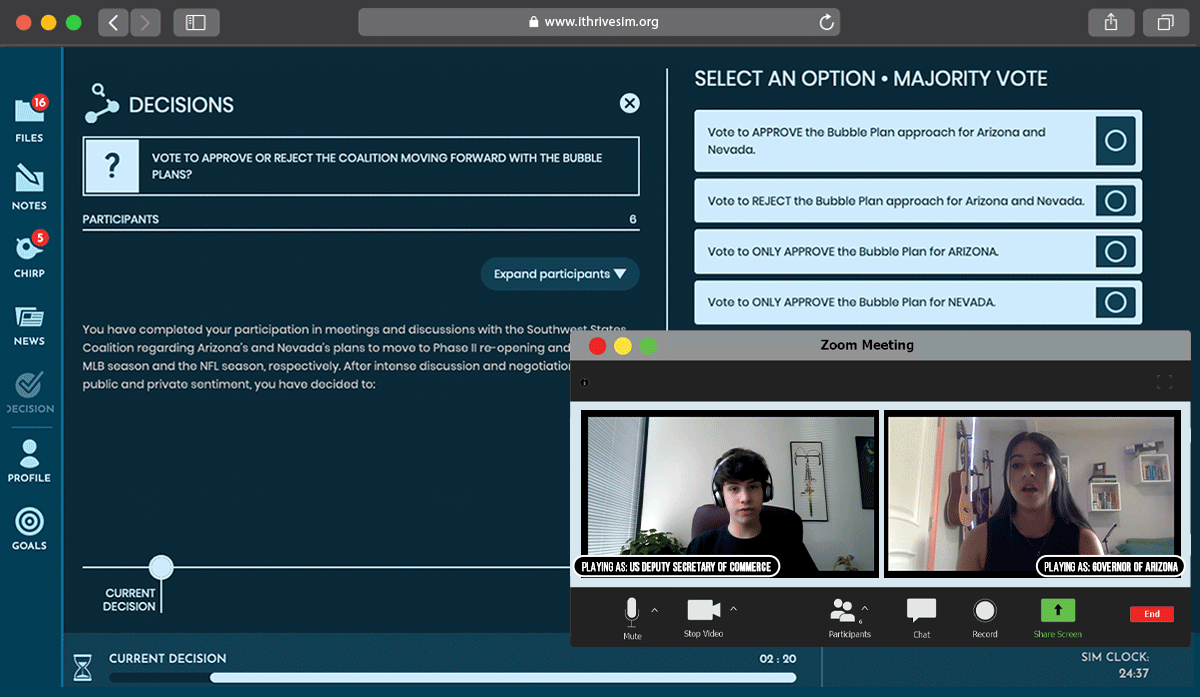
High school students playing iThrive Sim: Lives in Balance. See the gameplay in action here.
The simulations offered via iThrive Sim, our award-winning simulation platform that hosts dynamic role-playing games that scaffold educational content with social and emotional skill-building activities, encourage teens to learn by doing. Each one in our core civics library (Lives in Balance, Leading Through Crisis, and Follow the Facts) invites teens to play alongside their peers, prompts them to draw on their own experiences and their social and emotional skills while making decisions, demonstrate critical thinking, acquire and interpret information, and navigate challenges collaboratively. Dive into the social and emotional skill-building and civic learning that happens in each iThrive Sim game experience here.
3. Unleash teen creativity by inviting them to be game designers.
Why? As teens progress through adolescence and develop their capacity to reason thoughtfully and think critically, this three-letter question becomes all the more important and prominent in their lives. The cognitive growth teens undergo propels them to investigate the 'whys' that shape how they live and see their world. They move from thinking concretely and heavily relying on physical observations to thinking abstractly about possibilities. In this last major phase of development, where teens are primed to learn and adapt, curiosity becomes a growth point, and game design uniquely nurtures it in them. Our Game Design Studio Toolkit, developed in collaboration with EdTogether, sandbox games like Minecraft, and game-making tools like Roblox, provide teens with a springboard for unpacking complex challenges, investigating questions, and stepping fully into their creativity.
Games are unsurpassed in their ability to engage teens in physical and virtual worlds deeply. They offer teens a safe space to wander and wonder, exercise their innate curiosity, and build new understandings of themselves and each other. When used as a medium for engaging with young people in the spaces where they gather, they become more than entertainment—they become levers for social and emotional support.
How are you using play this school year? Let us know on Twitter by tweeting us @iThriveGames using the hashtag #GamesforThriving, and stay updated with our game-based resources and game design work, done with and for teens, by subscribing to our monthly newsletter.
iThrive’s 2021 Annual Report Celebrates Teen Genius, Community, and Play

Connection brings healing the same way co-creation brings innovation—through intention.
In 2021, we intentionally leaned into both, connecting with teens, educators, game developers, university partners, museums, and youth-serving organizations across the globe to co-design meaningful learning experiences that enlist the power of play to support teen thriving.
True to our mission and vision, we actively sought partners who want to engage young people in their genius and support them in developing the social and emotional skills to be in the world they will one day inherit with both empathy and curiosity. Bridging our partners' subject matter expertise with our co-design approach ensured that teen voice remained at the center of every tool, experience, and resource that sought to engage them. Our 2021 Annual Report, Building Community In Service of Teen Thriving, highlights all that we co-created, refined, and shared last year. Here are a some of the report's highlights:
- Our commitment to knowledge-building and knowledge-sharing brought us to conferences where we connected, learned from, and shared with game designers, researchers, educators, administrators, policymakers, and other intersectional experts across the globe.
- iThrive Sim, our award-winning ed tech tool that hosts immersive civic learning experiences, expanded with two new role-playing simulation scenarios: Leading Through Crisis and Follow the Facts, both of which were created with guidance and input from students, teachers, and subject matter experts.
- In May, we launched iThrive Curriculum's third game-based learning unit, A Moment in Time, an eight-lesson social and emotional learning experience that pairs with the mobile game Florence and supports teens in reflecting on relationships, grief, loss, and life shifts.
- Working in partnership with iThrive, youth designers at the SEED Institute created and launched The Run Around, a board game that mirrors their lived experiences in the juvenile justice system, authentically communicates its harm, and advocates for structural supports capable of disrupting it. Since launching, The Run Around has garnered press in The Boston Globe and won gold at Serious Games' 2021 Serious Play Awards.
- Working with High Resolves Group and Rise, an initiative of Schmidt Futures, we have been working on curating transformative educational experiences and making them widely available through Symphony, a new online tool that supports student-centered and self-directed learning.
An all-of-us approach is needed in supporting youth as they navigate the complex challenges of this time. A special thank you to every teen, educator, and collaborator who connected with us in 2021 and joined us in our commitment to creating learning environments and shared spaces that ignite and value the potential of young people.
Let’s Start Calling Social & Emotional Skills What They Are—Essential Skills

Before you read this article, take a look at your news feed.
You are more than likely to encounter an event or sentiment that attests to the increasingly polarizing and often unsettling world we live in and navigate. A recent survey published by USA Today shows that roughly half of Americans (48%) predict more destructive disagreements over the next ten years, but 93% say it's vital to reduce the country's current divides. How can we move toward realizing this unity amidst enduring divisiveness? We must build social and emotional skills. Social and emotional skills help us get better at togetherness. They are not 'soft'; they are essential, and nurturing them supports us in moving toward the more harmonious, just, and loving future we crave.
The Organisation for Economic Co-operation and Development (OECD) refers to social and emotional skills as "weapons against the greatest threats of our time: ignorance - the closed mind; hate - the closed heart; and fear - the enemy of agency." Social and emotional skills support us in taking an honest look at ourselves, really seeing each other, working together to find solutions to the complex challenges we face, and then persevering in enacting those solutions. Within education, thoughtful and equitable attention to social and emotional skills demonstrates a real commitment to equity more broadly; we can't expect equal outcomes unless we ensure all students are equally ready to learn in the first place. Social and emotional skills are undoubtedly critical to this readiness.
For this generation of teens especially, social and emotional skills are not just important; they are necessary. Social and emotional learning is the process of building and practicing social and emotional skills in schools. At iThrive, we embed this process in the game-based tools we create for and with teens, and use the connective and reflection-prompting power of play to build their social and emotional skills. Our iThrive Curriculum units, Museum of Me, Sam's Journey, and A Moment in Time, pair standard-aligned lesson plans with immersive video games to create learning experiences relevant to teens in high school English classes. These game-based learning experiences use digital media to encourage them to explore their identity, their emotional landscape, and how they navigate social relationships. Our civics-centered iThrive Sim games, Lives in Balance, Leading Through Crisis, and Follow the Facts, engage teens not just by supporting their understanding of the mechanics of government but of themselves, their identities, values, and communities. Each of these online simulations presents an opportunity to try on new perspectives, embody constructive decision-making techniques through role-play, and reflect deeply on how decision-making affects others.
These offerings for high school classrooms and youth-centered spaces were designed to encourage teens to develop the social and emotional resources that enable them to think for themselves and join others, with both empathy and curiosity, in learning, building, and imagining a better world. They also support teens and the adults they share space with in understanding that social and emotional skills are relevant to all subjects and aspects of life. The language we use to describe and advocate for social and emotional learning should reflect its standing as an essential part of the future we're all striving to attain—one that empowers us to live, work and thrive collaboratively, resiliently, and productively. Raising SEL's profile from that of a 'soft skill' to an educational and humanistic priority helps get us there.
Teens Have Big Emotions. How Can We Help HS Students Navigate Them?
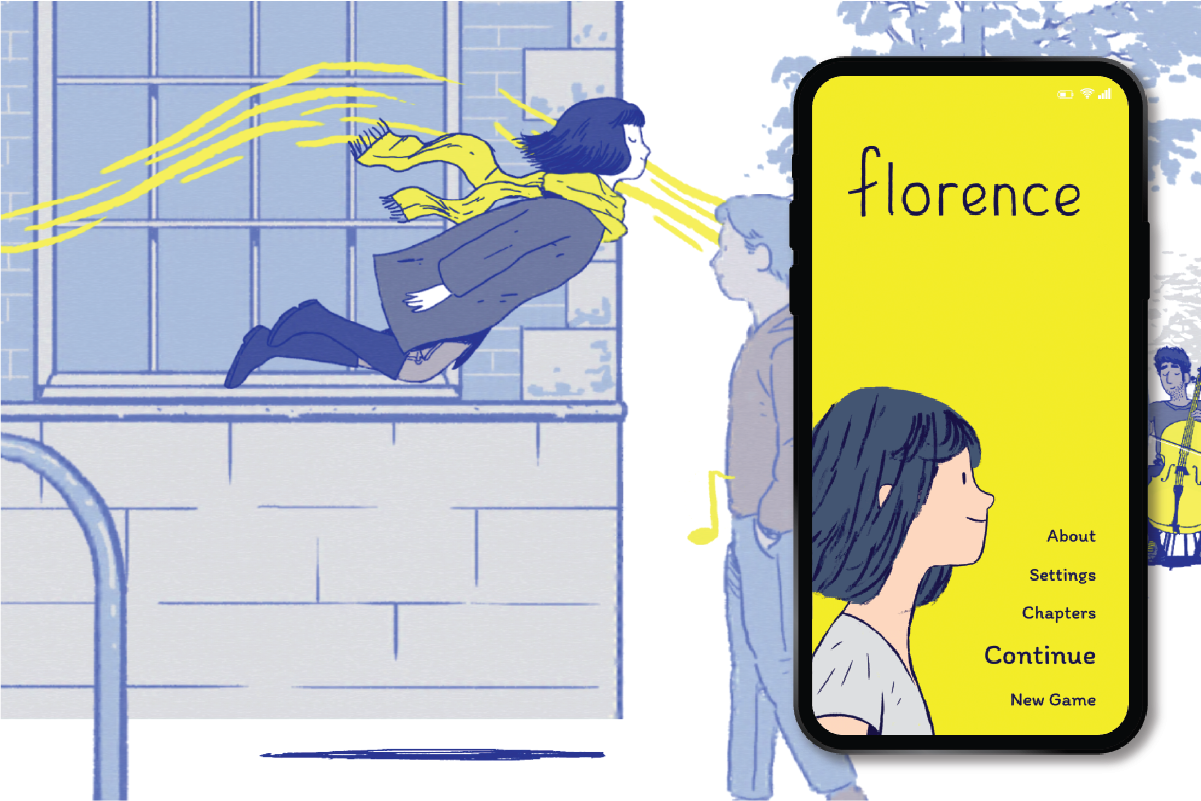
Teenagers have big emotions, and many already have a lot of unresolved grief at that age. Normalizing big emotions and offering tools for navigating this reality can is why social-emotional learning tools are necessary in high school classrooms.
I have been teaching high schoolers for about 20 years, and I am always asked how I manage the classroom so effectively and get them to be so responsive and receptive to my lessons. The short answer is that I recognize them as individuals. I validate their feelings. And I help them be self-aware and deliberate.
Even though many students need their hand held when it comes to recognizing and then communicating emotions and feelings, many of them are more than willing to do so in a safe space. If you can create such a space for your students and if you can reach them on a deeper personal level, the results will astound you. So, how do I do that? One way is to start with iThrive Curriculum: A Moment in Time.
iThrive Games invited me to co-create a lesson plan that would pair with the immersive media game Florence. The first step was to download the app and "read" the story: one that navigated the day-to-day life of Florence, an Asian-Australian 25-year-old whose aimless nature is universal and timeless for many young people.
There was much to unpack before I set about writing the lesson plans. What would I want my students to get out of this story? What lessons could be learned? What universal truths appear?
I immediately saw an opportunity to showcase lessons on non-verbal communication and symbolism, both of which can apply to real life. The story was told entirely with no words spoken; even when the characters are arguing, there is sound but no words. The power of communication was shown through images, sounds, movement, and gestures. This created an opportunity to discuss how these kinds of communication are prevalent in the students' everyday lives, even though they may not realize it or even think about it. The beauty of Florence is that it can be used in any classroom, especially in classes for English Language Learners (ELL), due to this nature of storytelling.
Symbolism plays a major part, too, and I definitely saw a way to help students relate to this, especially with two of the main characters having Asian and Indian heritage. It opened up many opportunities for students to discuss what cultural symbols they have in their life and how their background shapes who they are as a person. Having students choose objects that have significance helps reinforce the importance of sentimentality and the potential deeper meaning of objects in their lives.
But the real meat of the journey of Florence really lies in the weighty and emotional themes. One of the first themes I felt was important in this story is one of self-realization and identity. While Florence is significantly older than the students who will be reading her story, all can relate to the task of trying to figure out what their place is in the world. I believe so many students feel very lost about where they are headed, but I also believe that very few admit this out loud (or even to themselves). Showing them that self-realization and awareness is a long journey and that people often make mistakes along the way is an important lesson to be gleaned from Florence.
Overall, this story hits on so many levels and so many themes: including relationships, love, self-awareness, growing up, and ultimately (and the most impactful)-dealing with grief and loss. No matter who they are, every student has experienced grief or loss: of a loved one, of a friendship, of a piece of themselves that no longer exists, of a special place, etc. Tapping into this and showing them that grief over loss of so many things in their lives is not only normal but also incredibly understandable and expected is so important for teenagers who often lack the coping skills to grapple with such ponderous emotions.
iThrive Curriculum: A Moment in Time opens up the door to these ideas and shows students that everyone struggles in one way or another and that it is all about how one learns to deal with their issues.
Game-Based Learning Reads: Three Books That Will Make You a GBL Believer
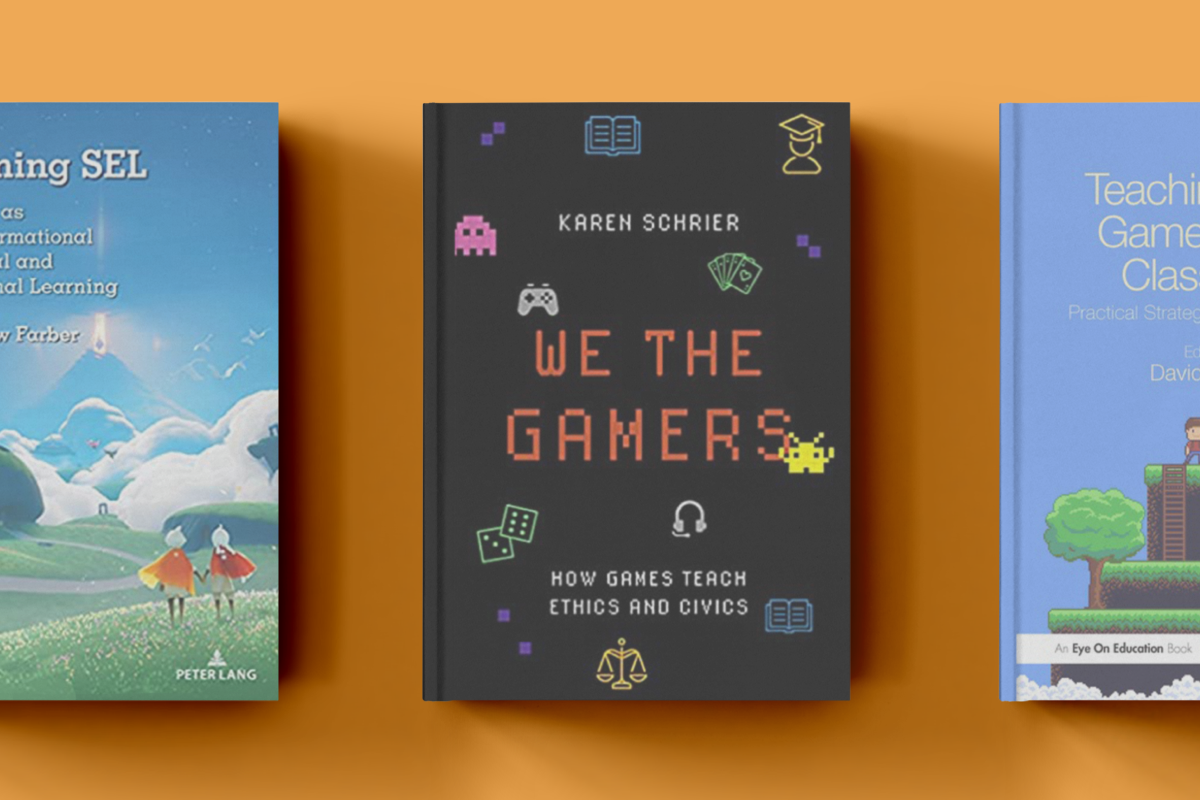
Game-based learning is part of iThrive's DNA as we support educators in bringing the power of play into the classroom. From impactful play and deep learning to personal transformation and social and emotional skill-building, the reasons to thoughtfully include games in educating young people continue to grow. Recently we have enjoyed the contributions of authors Matthew Farber, Karen Schrier, and David Seelow, who have written books adding to the body of knowledge related to game-based learning.
Karen Schrier, We The Gamers: How Games Teach Ethics and Civics
In this useful tome, Karen (Kat) Schrier explores the use of games in multiple contexts, from teaching ethics and civics, to creating connection and community, as well as for knowledge and action, and for critical thinking and inquiry.
Written during the pandemic, the book begins by exploring the many ways games were of great support to humanity during the stay-at-home orders and beyond. The author then takes a balanced approach by questioning when and how best to use games alongside learning, while acknowledging the limitations of games.
For educators who want to explore the power of games in the classroom, this one is a must-read.
Matthew Farber, Gaming SEL: Games as Transformational to Social and Emotional Learning
One thing that comes through in Matthew Farber's book on games and social and emotional learning is his deep love of and expertise in both. And we know that not only from the pages of this book but also because Matthew is a long-time collaborator with the team here at iThrive, having co-created Museum of Me.
Also written during the pandemic, the book is a very readable cornucopia of topics that span first-person accounts of gameplay and thought-provoking explorations of the neuroscience of games to comparing social and emotional learning models and contending with how games do or don't teach compassion, empathy, and mindfulness.
With practical information from links, lessons, and games, to well-woven-in peer-reviewed research, this book is useful to educators and caregivers who want to use games and understand why and how they are an asset for young people.
David Seelow, Teaching in the Game-Based Classroom
In this collection of strategies for game-based learning, editor David Seelow has culled the best teachers, researchers, and games to provide hands-on guidance for adults looking to introduce games into their classroom or youth encounters.
The introduction also stresses the multiple pathways one can take to succeed with game-based learning and ultimately help transform both teacher and student learning.
With contributors such as Paul Darvasi, Lindsay Portnoy, Claudia-Santi F. Fernandes, and more, the strategies offered within span empathy-building and support for wellness to project-based learning and useful feedback loops. A useful book for educators who want to use games to transform learning.
Interested in integrating game-based learning in your classroom this fall? Check out our iThrive Curriculum units and newest iThrive Sim role-playing simulation games, Follow the Facts and Leading Through Crisis, to get started!
Burgeoning Journalists Try on Their Roles in New Media Literacy Game

Media literacy incentivizes good journalism. In early June, two dozen high school students enrolled in the Summer Journalism Institute at the Walter Cronkite School of Journalism and Mass Communication, Arizona State University, stepped into a simulated newsroom to play iThrive Sim: Follow the Facts and discovered this. Follow the Facts is a media literacy-centered, role-playing simulation game where players, acting as journalists, sift through information and sources to find and share the truth about a mysterious illness and an impending storm in New Orleans.
Playing the roles of Lifestyle Reporter, Metro Reporter, Government Reporter, Opinion Reporter, and News Editor, students (in teams of five) engaged with in-game social and print media, practiced effective sourcing of information, explored bias, and engaged in collaboration. In a collaborative gaming experience that combined media literacy skill-building, social-emotional learning, and civics education, the 24 students who played got the chance to:
- Describe how the media shapes public opinion and behavior.
- Collaborate to see the bigger picture of a situation and create accurate news.
- Successfully rank the quality and value of varying sources of information.
- Practice effectively sourcing information in a digital world, an integral media literacy skill in the 21st century.
- Become aware of and describe bias and its impact on reporting, selecting, and interpreting the news.
- Demonstrate self-management while under stress.
- Practice clear communication.
The burgeoning journalists were highly engaged. Halfway through the game, they shared their learnings around journalism and media literacy, such as:
- "[I learned] To pay attention to details, work in teams, [and] make important formal decisions."
- "I learned that it's important to gain public trust by putting out specific and true information."
- "I learned how to make beneficial decisions under pressure. It also gave me the experience of being a journalist."
- "I learned that journalists have to handle a lot of information at once and work together to make decisions."
- "[I learned] journalists have a limited amount of time and must prioritize what they think is the best thing to do."
- "[I learned] That you really need to communicate with your team to have all of the information."
- "I learned that getting the facts/right info depends on how you choose your sources."
- "[I learned] only take information from verifiable sources."
Staff were energized by the engagement and thoughtfulness of the players.
"It was validating to see the students really deliberating over the decisions in the game and collaborating with each other to make the best choice," said Michelle Bertoli, Senior Director of Learning. "There aren't easy answers, just like in real life. It's such a great opportunity to dig deep and practice managing your own attention and emotions while you work closely with others towards a common goal."
To close out the experience, iThrive staff will lead a debriefing session based on the pre-written curriculum that accompanies the media literacy-centered simulation game. Follow the Facts is now available for summer enrichment programs and other youth-serving experiences. Sign up today to play the game with your students!
Add Play to Your Summer School Schedule: Virtual Conferences in July

After an unprecedented year, summer school programs are underway in several states across the nation, with an increased focus on students' social and emotional health. Game-based learning uniquely aligns with the times. When games are used in the classroom, they offer students a space to immerse themselves in new information, actively apply that information while problem-solving, try on new perspectives, and work in self-directed independent ways. The connective power of games also supports community-building and empathy, making play a springboard for responsible civic engagement.
As school administrators and teachers explore ways to enrich their classrooms this summer and later this fall, we're excited to continue putting game-based learning and SEL front and center at upcoming conferences where iThrive staff will be presenting. If you're interested in bringing games to your summer school program or classroom next school year, here are some interactive meetings to put on your calendar this month:
2021 Games for Change Virtual Festival (Monday, July 12th to Wednesday, July 14th, 2021)
The 2021 Games for Change Virtual Festival will feature virtual sessions hosted by an array of thought leaders on the transformative power of games and immersive media. iThrive's Executive Director and Chief Scientist, Susan E. Rivers, Ph.D., will be part of a session titled "Disinformation Games," where she'll discuss iThrive Sim: Follow the Facts, our new role-playing simulation game that supports media literacy skill-building. Join in on the session happening on Wednesday, July 14th at 5:30 ET/2:30 PT for a rousing discussion by registering here.
2021 NASSP National Principals Conference (Wednesday, July 14th to Friday, July 16th, 2021)
The theme of this year's NASSP National Principals Conference is "Together, We Will," with strands centering on equity, wellness, and innovation. We're excited to share our vision of how play supports each of these strands with all who'll be in attendance. In our interactive session, attendees will play iThrive Sim: Lives in Balance, our online role-playing simulation game that focuses on federalism and states' rights and uses a pandemic as the backdrop for practicing negotiation and decision-making. Players, acting as state governors and federal officials, will be tasked with moving the action forward themselves, aided by online gameplay and iThrive Sim's dynamic tech. They must work individually and as a group to assess the information at hand, defend their points of view, and make decisions that produce the desired outcomes in time. Register here to attend this conference, get in on the game, and learn how play can enrich your summer school program or school this fall.
More Ways to Meet
This fall, we'll be back on the road, virtually and in person, to share more on games, play, and their contribution to students' academic growth and social and emotional learning. There are many ways to engage with us. Learn about our game-based learning curricula and role-playing simulation games guaranteed to boost student engagement in your summer school classroom. Send us an email. Or sign up for our newsletter to stay in the loop with exclusive playtesting opportunities.
We look forward to connecting with you!
Media Literacy and Responsible Civic Engagement Go Hand-in-Hand

We know that media literacy is essential. Misinformation and disinformation campaigns from various entities have influenced everything from our elections, public sentiment, and individual decision-making. Media literacy is part of the solution to combat misinformation. Educators who teach media literacy are helping students contend with important questions. How do we detect biases? What sources of information can we trust? How do we apply critical thinking to the information that we take in through written and visual media?
We think it's imperative that teens have the opportunity to practice media literacy in the classroom. Young people are curious, consume tons of media, and are more than equipped to think and talk through these hard questions. So we created iThrive Sim: Follow the Facts to assist educators in exploring media literacy in their classroom. In this role-playing simulation, students play reporters sifting through information and sources to find and share the truth about a mysterious illness and an impending storm in New Orleans.
iThrive Sim: Follow the Facts was created in collaboration with subject matter experts such as Elizabeth Smith, Assistant Professor in the Communications Division at Pepperdine University. We asked Ms. Smith to share her thoughts about the power of media literacy in the lives of young people.
Q: WHY DO YOU BELIEVE MEDIA LITERACY IS SUCH AN IMPORTANT TOPIC FOR HIGH SCHOOL STUDENTS TO LEARN?
A: I believe media literacy is an important topic for people of all ages because, like it or not, we are surrounded by media all the time. The more literate we can become, the better we will be at understanding the origin, nature, and effects of our media consumption. More specifically, I think it is critical for us to invest in news literacy education with all learners, starting in kindergarten. High school students show us that they are not uninformed about news topics but find that many news outlets do not cover topics that they find relevant to their lives. Additionally, many high school students are confronted with news being shared on social media but aren't always clear what makes credible news, how news information evolves (especially in breaking news simulations), and what to think of the work of journalists. However, as high school students grow into adulthood, they will be asked to make informed decisions that will rely on credible, rigorously vetted information as news is. Knowing who and what is high-quality news information will help these emerging adults make informed decisions and understand others better.
Q: WHAT ELEMENT DID YOU THINK WAS MOST IMPORTANT OR TRANSFORMATIVE IN ITHRIVE SIM: FOLLOW THE FACTS?
A: I think the most transformative element in iThrive Sim: Follow the Facts is making decisions about what information to share. This pushes students to make relatively quick decisions about what is correct. Sometimes the details that differentiate two different pieces of information are subtle, which means students have to pay close attention to make quick, timed decisions. They talk about these decisions with their teammates. I think two elements are important: 1) The decisions are timed, so they are making decisions about information to share in real-time, just as a journalist does but also just like they do when they are more casually using social media in their personal lives; 2) Discussing the decisions helps them to share and build knowledge.
Q: HOW DO YOU SEE MEDIA LITERACY SUPPORTING RESPONSIBLE CIVIC ENGAGEMENT?
A: Media literacy, but more specifically, news literacy, helps individuals understand what the news is and what questions to ask about news information. News literacy does not promote that individuals or communities should blindly trust the news. Rather, news literacy should empower individuals to ask good questions and understand the process behind reporting and news production.
Q: WHAT'S YOUR FAVORITE PART OF THE GAME?
A: Honestly, I love the whole thing! My favorite part of the game is watching teams work together and hearing the way they support each other to make solid, informed decisions.
BRING MEDIA LITERACY SKILL-BUILDING TO YOUR CLASSROOM
If you'd like to bring Follow the Facts to your high school classroom or summer program, let us know! You can sign up here to learn more information or to request a time slot for your class. The "news office" opens on Friday, June 25, 2021!
Learn about the Power of Play at these Upcoming Conferences

2021 SERIOUS PLAY CONFERENCE
The Serious Play Conference this year features different tracks and multiple sessions with the common theme of using games or simulations in training and education. Our session on Wednesday, June 23, 2021 from 2 to 3:15pm ET will be presented by Executive Director and Chief Scientist Susan E. Rivers, Ph.D., and Senior Director of Communications Nicole Taylor. Stress Storm/New Norm: How Role-Playing Simulations Can Help will explore how role-playing simulations can be used in the workplace to assist leaders in identifying opportunities for coaching people managers and staff members.
The ability to practice social and emotional skills such as self-management, emotional awareness, social awareness, and responsible decision-making under stress is necessary for a healthy culture and optimal performance. Being able to observe how leaders perform under stress is a high-value opportunity provided by role-playing simulations. Using iThrive Sim: Lives in Balance, Susan and Nicole will share how a role-playing simulation can be used both to observe stress behaviors, assist people managers in identifying and working with their stress response, and provide opportunities for coaching to improve how staff members manage themselves and others. If this lights you up, register here.
2021 ASCD CONFERENCE: EMPOWERED AND CONNECTED
The theme for this year's ASCD conference is Empowered and Connected. The annual conference is full of sessions that will accelerate your summer learning plans and help get you prepared for the school year. At our session, Susan Rivers will be joined by educators Paul Darvasi and Mira Cohen to present Play to Thrive: A Game-Based Approach to Social and Emotional Learning for High Schools. If you're heading to ASCD, this session will allow you to:
- Walk away with free, classroom-ready game-based social and emotional curriculum and tools to use immediately for in-person and distance high school humanities courses.
- Understand how game-based learning approaches align with teens' specific developmental, social, and emotional needs.
- Discover a roadmap for infusing core curriculum with playful, tech-supported interaction for high school students' social and emotional growth.
Sound useful for your classroom? Register for ASCD Empowered and Connected.
COALITION FOR JUVENILE JUSTICE (CJJ) 2021 ANNUAL CONFERENCE
The Coalition for Juvenile Justice (CJJ) is a nationwide coalition of State Advisory Groups (SAGs) and allies dedicated to preventing children and youth from becoming involved in the courts and upholding the highest standards of care when youth enter the juvenile justice system. At CJJ's 2021 virtual annual conference, iThrive's Susan Rivers, Transition HOPE's Janelle Ridley and iThrive youth designer Bernardo S. will be sharing a session on Friday, June 11th from 10 to 11:30am ET entitled "Designing Games with Youth Experts to Dismantle Unjust Systems." They'll share the story of youth game designers who created a game called The Run Around to delineate their lived experiences in the juvenile justice system and advocate for changes to it. They'll also share how decision-makers can bolster supports for the well-being of incarcerated youth. You can register for this event here.
MORE WAYS TO CONNECT
Next month, we'll share the conferences iThrive is presenting at for the remainder of the summer. There are many ways to engage with us, and we look forward to connecting with you.
Use this SEL Activity to Help Your Students Process Pandemic Grief and Loss

For many teens this last year, grief and loss have been a part of life. For some it was the loss of in-person schooling and the accompanying social activities and for others it was missing or needing to adapt milestones and rites of passage, or grief that stemmed from sick family members or the over 500,000 souls in the U.S. lost to Covid. Whatever the specifics were, loss has been palpable both personally and collectively.
And now, as vaccinations are on the rise and we begin to emerge, the opportunity to see the rainbow after the rain is also here. We created iThrive Curriculum: A Moment in Time, to support teachers and teens in navigating these emotions together.
GRIEF AND GROWTH IN ITHRIVE CURRICULUM: A MOMENT IN TIME
A Moment in Time is a game-based learning unit for high school English Language Arts classes. Created in collaboration with iThrive staff, high school ELA teachers, and teachers in training, the unit uses the interactive story and video game Florence as the central text. Students follow Florence's journey through a few major life changes and see how she copes and grows as a result. It's a wonderful opportunity to support students in reflecting on their own journey with grief, loss, and change this past year, and exploring some positives that were on the other side of that storm.
According to one 10th grade teacher who piloted the iThrive Curriculum: A Moment in Time, "The students really got into it and went into a lot of depth in their reflections."
We look forward to educators' downloading the unit when it is launched at the end of May. In the meantime, we'd like to preview one exercise from the unit that can be of service as a standalone activity before the year ends, to help students process how they experienced the grief and loss of the pandemic.
AN SEL ACTIVITY FOR GRIEF AND LOSS: "AFTER THE RAIN, THE RAINBOW"
Step 1: Invite students into present-moment awareness using a tool of your choosing. We like to set a timer for 45 seconds and invite students to take 10 belly breaths during that time.
Step 2: Offer these journaling prompts for their self-reflection:
- How have you coped with a loss in your own life? Write down a strategy or two.
- What have you discovered about yourself in processing the loss?
- What is one positive thing that came out of the experience, even though there was loss?
Step 3: After sufficient journaling time, put students into pairs and allow them to discuss their answers to journaling prompt #3.
Step 4: As a class, invite anyone to share with the whole group.
This social and emotional learning exercise invites students to nurture their self-awareness and self-management skills while reflecting on their experiences of grief and loss. The iThrive Curriculum: A Moment in Time unit touches on the same themes across eight pre-written lessons for 9th and 10th grade ELA and humanities classes. Bring it to your classroom today!
iThrive Sim: Lives in Balance Named a 2021 GLAMi Award Winner

BOSTON--iThrive Sim won a bronze award in the GLAMi Award 2021's Interactive and Immersive category. Created by iThrive Games in partnership with Ronald Reagan Presidential Library and Museum, iThrive Sim is an innovative virtual augmented reality experience that provides an opportunity for meaningful and engaging experiences. The sim is currently used with museum-based, hybrid, and virtual visitors, and in traditional educational spaces.
According to the website for MuseWeb, the host of the GLAMis, "The annual GLAMi (galleries, libraries, archives, and museums) Awards recognize and celebrate innovative projects in the cultural heritage sector."
Susan E. Rivers, PhD, Executive Director and Chief Scientist at iThrive, sees immersive games as a true opportunity to support visitors in social and emotional learning: "Play is important for all of us," she said. "It brings us together in community. Play helps us create new solutions to problems...solutions we wouldn't have thought of otherwise."
iThrive Games is pleased to offer three iThrive Sim civics scenarios for learners who are high school aged and older: Lives in Balance, which explores collaboration and compromise during a pandemic, Leading Through Crisis, which explores responsible decision making during a critical event, and Follow the Facts, which explores media literacy during a natural disaster.
Mira Cohen, Director of Education at Ronald Reagan Presidential Library and Museum, says the virtual simulation was an important way to keep visitors connected during the pandemic, and beyond. "Through engaging audiences in meaningful and fun in-depth experiences, using historical records and government documents, we are able to increase our audience base, keep our current audience base engaged and further appreciation for the value of record keeping to our democracy, she said."
To learn more about iThrive Sim, visit https://ithrivegames.org/ithrive-sim/. To learn more about additional programs at Ronald Reagan Presidential Library and Museum, visit https://www.reaganlibrary.gov/.
###
Media Contact
Eghosa Asemota
eghosa.asemota[at]ithrivegames.org
About iThrive Games
iThrive Games prepares teens to thrive by meeting them where they are and working in partnership towards a world where all have the voice, choice, and agency to reach their full potential. We use games and game design to equip teens with the social and emotional skills they need to be healthy and resilient.
2020 Annual Report: A Year of Play, Co-Creation, and Community
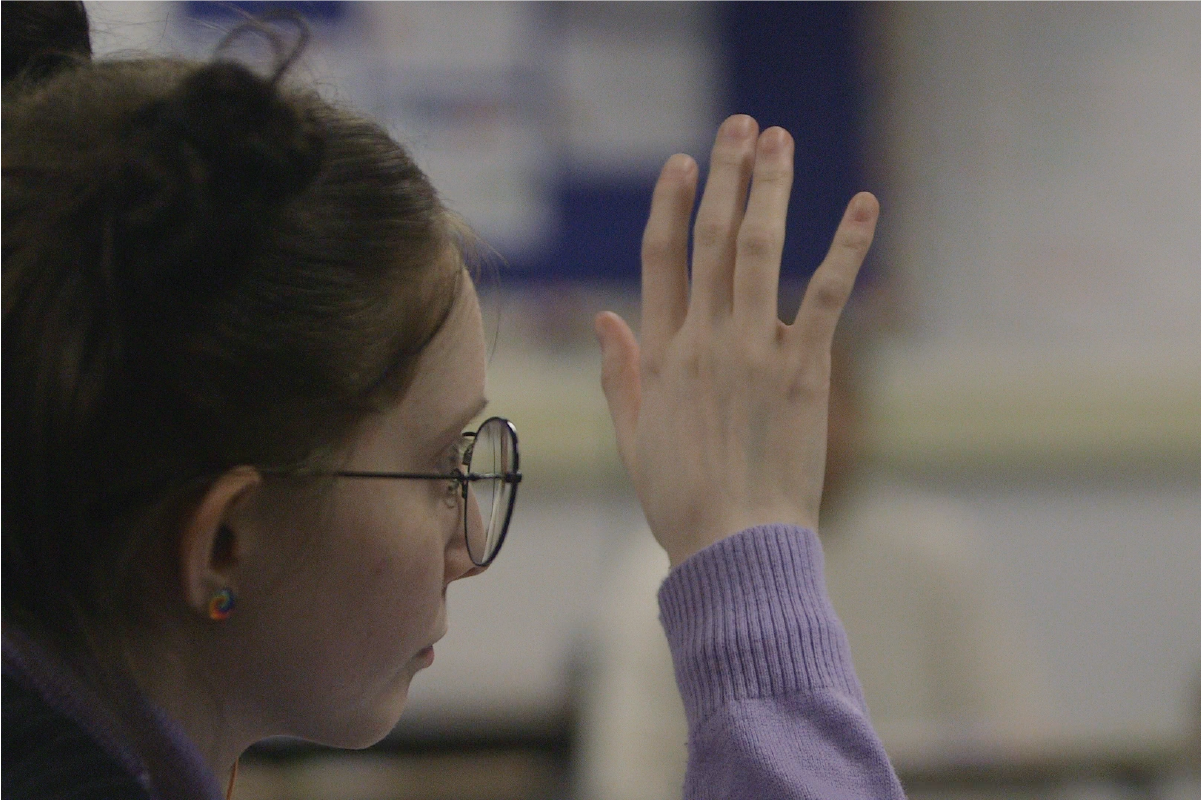
The strands of iThrive's DNA are composed of understanding the power of play. Social and emotional learning. Belonging and engagement in the spaces where teens are. Being teen and educator-centered.
Thank you to each of the teachers, teens, and collaborators who share those same building blocks at their core. Here are our highlights from last year:
- We appreciate the 120 of you who downloaded iThrive Curriculum: Sam's Journey and/or iThrive Curriculum: Museum of Me.
- Shout out to the over 400 teens who playtested iThrive Sim: Lives in Balance.
- High five to the teachers who completed over 90 play sessions of iThrive Sim in their classrooms.
- Game developer friends, we see you. Thanks for downloading our game design kits over 250 times last year.
- Parents and other adults, we appreciate your interest in our game guides, which you downloaded over 130 times.
For more information on how we are working to further our mission of using games and game design to equip teens with the social and emotional skills they need to be healthy and resilient, the tools that support and protect their mental health and well-being, and the systems thinking they need to recognize inequity along with meaningful opportunities to imagine and design a better world, view our annual report.
Designing for Equity: Five Principles for Curriculum Development
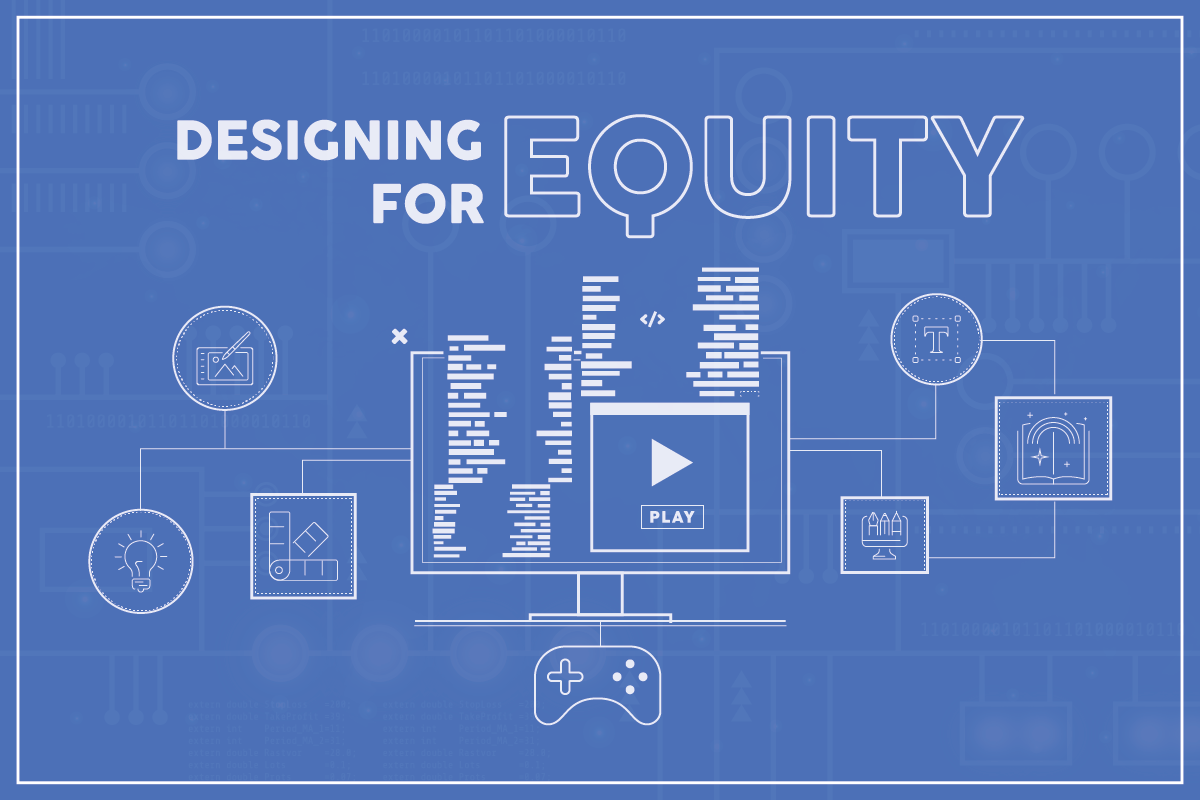
Last summer, like others in the education and game design space, we articulated a commitment to anti-racism, specifically to use "an anti-racist lens to review our offerings, making any changes that are necessary, and applying that lens as we create new ones." To actualize that commitment we were fortunate to be connected with Jessica Heard, a consultant for racial equity in education, who agreed to review our offerings and to collaborate with us on creating a set of design principles that we could use going forward.
It was a meaningful experience for the team to have light shed on some of our blind spots, and to see where we had gone part of the way toward equity but still had room to go further. To that end, we are making changes to some of our curricular units, and have already shared a bit about changes we made to iThrive Curriculum: Sam's Journey and iThrive Curriculum: Museum of Me.
While there's plenty more work to do, we are excited to move forward with our guiding principles for equity-centered design here at iThrive Games. Here are the high-level principles that we commit to using as we continue to create our game-based, social and emotional learning units:
1. Promote authentic representation of marginalized communities.
Examples of actions include consulting with members of underrepresented groups whose stories are portrayed in our units; making space to reflect on how those stories are represented for non-dominant groups, beyond the academic standards; paying special attention to tying in systemic considerations; and selecting media images and footage that celebrate the diversity of humankind.
2. Promote accessibility for learners/players with various learning needs.
While Universal Design for Learning was already a core principle at iThrive, additional examples include creating space during ideation of products for other equity-centered features, such as translation into other languages and game modifications for varying reading levels.
3. Promote critical consciousness and reframe content from a decolonizing lens.
Rather than inferring our commitment, we will name the practices and tools we recommend related to racial and social justice, Universal Design for Learning, and to trauma-informed, equity-centered, and transformative social and emotional learning.
4. Promote design that considers the whole person and highly variable lived conditions of learners/players.
Examples include preparing teachers for the possibility that all learners / all parents of learners may not be emotionally available for or willing to engage with the content, incorporating trauma-informed practices, thinking about anticipated lived experiences and supporting teachers to hold space, and accessing partnerships and resources that can enrich and expand our areas of expertise.
5. Promote bringing in community in those places where we are still learning.
For example, at all steps of the design process, from ideation to implementation, find ways to involve critical thought partners to review and inspire us to keep reaching for equity.
We share these principles to be transparent in how we work and what we value. We would love to hear from other educational and game design companies about how you are committing to equity in your work. Sign up for our newsletter to stay informed about exciting, equity-driven changes to our products.
Diversify Your HS ELA Reading List With These Poems by Writers of Color

Teachers—are you looking for additional ways to highlight voices from all communities? We are too and recently found an opportunity to do so in our English Language Arts unit iThrive Curriculum: Museum of Me. This game-based and social and emotional learning unit invites students to explore the story of the family at the center of the video game What Remains of Edith Finch. In one lesson, as students uncover the choices that were made in Edith's family, they are invited into a reflection on their own choices, through the lens of poetry. In revising the unit to include a diversity of voices, we found that we could highlight the work of these poets of color.
Here are five poets that can enrich your classroom:
- Ha Jin, author of A Center. This poem is part of a larger collection of poems, A Distant Center, which includes meditations on the meaning of home.
- Nikki Giovanni, author of Legacies. This poem provides an opportunity to discuss unspoken meanings and the choices we make in communicating with family members.
- Joy Harjo, author of A Map to the Next World. This poem explores the choices that connect us with one another and with nature and those that don't.
- Maya Angelou, author of Caged Bird. This poem explores privilege and oppression and the choices one makes within both.
- Rita Dove, author of Dawn Revisited. This poem invites students to reflect on the choices that are presented with the dawning of a new day.
When students from all cultures can see themselves in the books, poems, and games that are brought into the classroom, we are one step closer to creating equitable classrooms, enriched by the diversity of all of our vast experiences.
10 YA Novels by Authors of Color for Your HS English Classroom

As part of the commitments we made in our anti-racist statement back in June, we are reviewing our educational offerings for opportunities to make them more equitable and to see where we can uplift and center voices of color and those from underrepresented communities. One way we can do this is in our curricular units, such as iThrive Curriculum: Sam's Journey—an English Language Arts and humanities unit for high school students. The narrative at the center of Sam's Journey is the game A Normal Lost Phone, which is unpacked message by message as players unlock information in Sam's phone.
In our equity review of the unit — and inspired by the game's mechanism of telling a story largely through text messages and emails — we found there were opportunities to extend the unit by linking it to epistolary novels we love (or that have been recommended to us) that were authored by writers of color.
We combed through our favorite YA books and asked our teacher friends for recommendations. Here are 10 awesome young adult epistolary books by authors of color that you may wish to use in your classroom:
- Monster, by Walter Dean Myers. In movie script format, 16-year-old Steve Harmon tells the story leading up to the most pivotal event in his life.
- To All the Boys I've Loved Before, by Jenny Han. Lara Jean writes love letters to every boy she's loved and keeps them safe in a special place. Everything changes when the letters make their way out into the world.
- Dear Martin, by Nic Stone. Justyce Mcalister has had a brush with police brutality. In trying to make sense of it, he begins journaling to Dr. Martin Luther King Jr., inquiring about the usefulness of those teachings today.
- The Absolutely True Diary of a Part-Time Indian, by Sherman Alexie. Junior is growing up on the Spokane Indian Reservation, and he tells his story through a mixture of writing and art.
- The White Tiger, by Aravind Adiga. Balram Halwai shares the story of his life in India through a letter to a Chinese political figure.
- Between the World and Me, by Ta-Nehisi Coates. In letters to his adolescent son, author Ta-Nehisi Coates shares the experiences that have evolved his understanding of his place in the world as a Black man.
- The Color Purple, by Alice Walker. In letters to God, Celie shares the story of her life and her journey toward self-acceptance.
- Tears of a Tiger, by Sharon Draper. In letters, homework assignments, and articles, the story of high school student Andy's journey of grief and guild is unveiled.
- In the Time of Butterflies, by Julia Alvarez. This novel shares the story of four sisters who fight against an authoritarian regime in the Dominican Republic.
- Zenzele: A Letter for My Daughter, by J. Nozipo Maraire. A mother writes letters to her daughter, sharing life lessons and her experience of Zimbabwe's struggle for independence.
You can find many of these books on commonsensemedia.org to assess their themes and age appropriateness for your classroom. We hope this list is helpful in building out resources for high school classrooms that elevate the voices of people of color.
2020 Wrap-Up: A Gameful Year of Connection, Creativity, and Play

2020 was not an easy one by anyone's standards. Educators scrambled to learn how to deliver distance learning and to change all of their lesson plans to an online format. Students struggled with the loss of much of their in-person social life and with the transition to learning from home. Parents managed working while trying to help their children with online learning. And nationally, as we grieved our pandemic-related losses, we also collectively faced systemic racism, with many finding ways to begin to make changes from where they stood.
While not easy, there was still the opportunity for social and emotional learning and joy in 2020. Whether we found new ways to connect with family and friends through play online or whether we had a lot of obstacles to overcome, we made it—because we are still here.
Like everyone else, at iThrive we had our ups and downs and lots to adjust to in 2020. We were happy to officially release iThrive Curriculum: Museum of Me, to collaborate with educators on the creation and release of iThrive Curriculum: Sam's Journey, to playtest our new role-playing simulation, iThrive Sim, with over 400 students, and to collaborate with our colleagues at the Situation Room Experience to create the civics-based Lives in Balance and Leading Through Crisis scenarios for our simulation game.
We appreciate you for the many ways you engaged with us, whether it was downloading one of our game-based learning units, attending one of our webinars, playtesting our role-playing simulation, or reading our articles. Below are the blog posts you read the most this year.
Top Five Blog Posts of 2020:
- Social Distancing and Staying Connected Through Games: Read about how playing games together at home can relieve stress, bring joy, and foster connection.
- Urban Assembly Students Create COVID-19 Choose-Your-Own-Adventure Story: Read about our first virtual Game Design Studio, held with students from Urban Assembly. We co-designed an interactive story game reflective of the students' experiences navigating the social upheaval of the pandemic.
- COVID Self-Care Package: Practicing #SELatHome: Try out our 14-day challenge to practice social and emotional learning (SEL) and self-reflection at home. Social and emotional skills are even more useful in times of confusion, crisis, and abrupt change.
- Games to Play While Social Distancing: MMORPGs: Read about how massively multiplayer online role-playing games (MMORPGs) can be a safe space to wander, explore, and connect with others.
- Staying Connected While Social Distancing: Games for Emotional Coping: Take a look at our gameful recommendations to help you practice self-care, savor life's best moments and experiences, and turn inward to explore, accept, and express what's challenging about this moment.
We hope that each of you has a wonderful holiday season. We'd love to stay connected with you. Click here to receive our monthly newsletter with resources and updates. Here's to more creativity, connection, and play in 2021.
iThrive Games to Join The Great Exchange: Student Engagement Summit
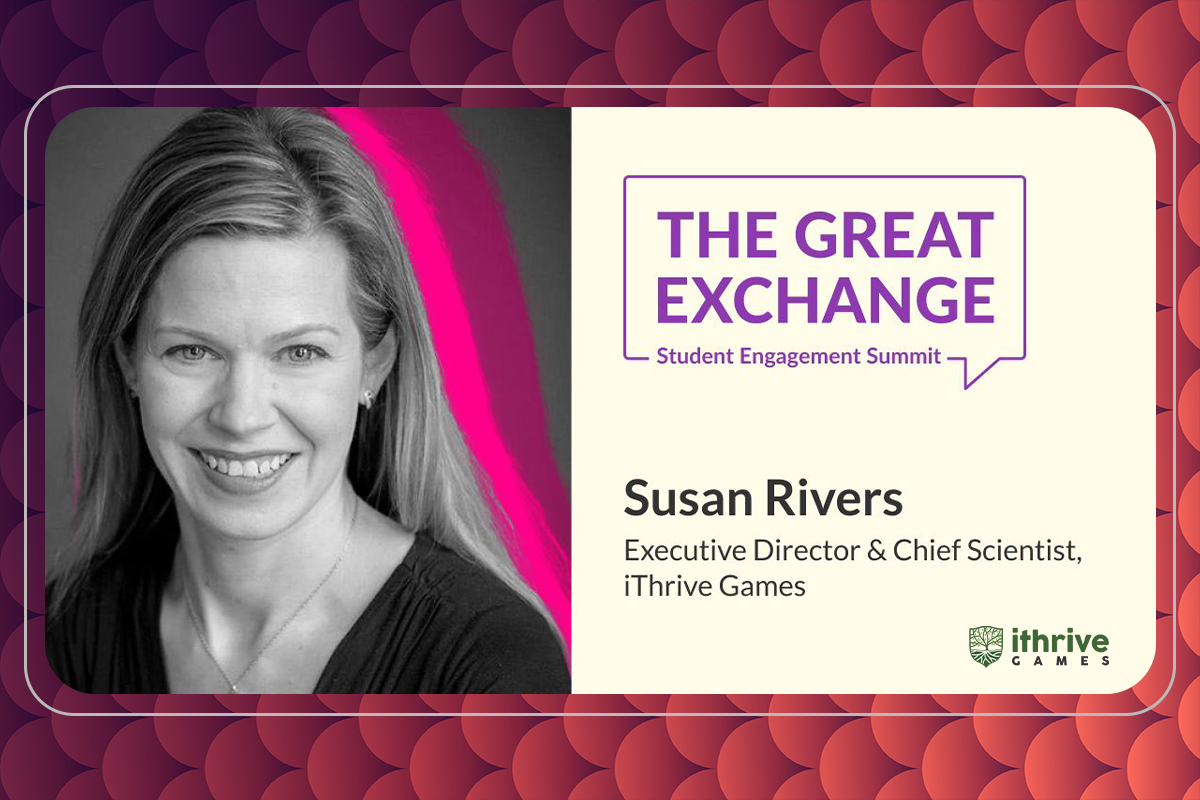
CLICK HERE TO REGISTER FOR THE #GREATEXCHANGEDU: STUDENT ENGAGEMENT SUMMIT
Susan E. Rivers, PhD, Executive Director and Chief Scientist at iThrive, is looking forward to speaking at The Great Exchange: Student Engagement Summit, produced by Classcraft and Google for Education. This virtual event, on Thursday, October 29th, brings together education innovators from across the sector in service of sharing practices for engaging students more deeply.
Dr. Rivers will be part of the panel discussion "How can games promote equity?" along with David Adams of Urban Assembly, Jennie Magiera of Google, and Devin Young of Classcraft. They'll discuss how games can engage all students by making learning more culturally relevant, reducing unconscious bias, and fostering intrinsic motivation.
"Distance learning is an opportunity for us to be even more intentional about embedding social and emotional learning and finding new ways to engage students," said Dr. Rivers. "I look forward to discussing how game-based learning invites students to try on new identities and gain new perspectives."
This virtual event is free of charge so that anyone who wants to learn and engage can do so. Click here to register for The Great Exchange: Student Engagement Summit. Stop by our booth at the virtual expo, where we will be sharing more about our civics game iThrive Sim: Lives in Balance. Hope to see you there!
Call for Nominations: iThrive Games’ Educator Advisory Council
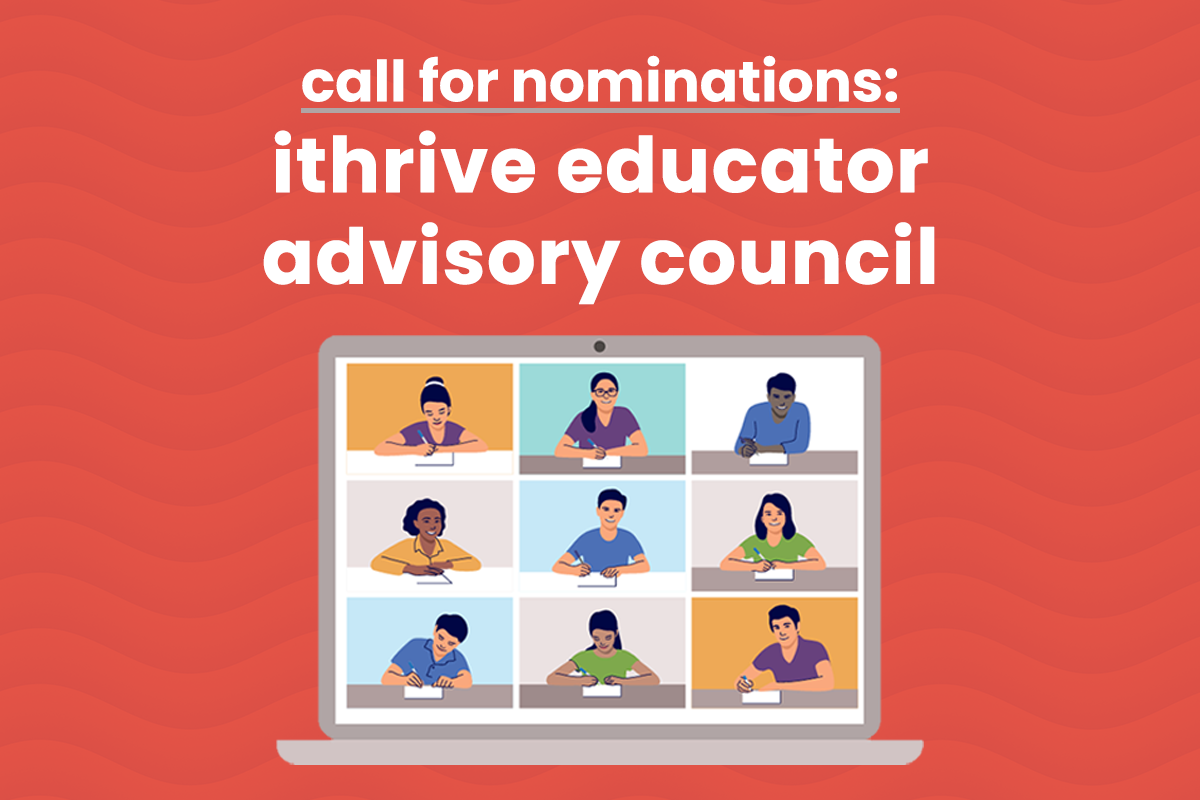
The iThrive Educator Advisory Council is a national hub of teachers that advises and supports iThrive Games Foundation in its mission to use games to equip teens with the skills they need to be healthy and resilient, the tools that support and protect their mental health and well-being, and the systems thinking they need to recognize inequity along with meaningful opportunities to imagine and design a better world.
Councilmembers are high school social studies and English Language Arts teachers and administrators who bring the perspective of passionate educators with deep insight into who teens are as people and as learners. Councilmembers will offer feedback on and promote resources for educators and teens that encourage student engagement, deep learning, and meaningful connection.
iThrive commits to working with teens from traditionally marginalized groups, especially people of color, women, members of the LGBTQ community, those living with disabilities, English language learners, and those from working class backgrounds. We believe educators who teach these groups must be centered in the work that we do, so teachers who bring these experiences are encouraged to apply.
Benefits:
- Virtual meeting that requires no travel
- Meet new peers, connect with other teachers and engage in enriching conversations in community
- Gain insight into deep knowledge on game-based learning and social and emotional learning
- Visible listing on the iThrive's website as an iThrive Educator Advisory Council member
- Honorarium for quarterly meetings and playtesting encounters
Responsibilities:
- Bring your innovative, inspired perspective that contributes to forward thinking
- Commit to one term (two years of membership)
- Attend quarterly advisory committee meetings online
- Provide feedback on iThrive programs and initiatives
- Notify colleagues of education program offerings at iThrive
You can nominate yourself or someone you think would love collaborating with us. Please fill out this form to apply or nominate a teacher you know, and contact us here if you have any questions. Nominations are open and will be considered on a rolling basis.
Game-Based Learning 101: How to Choose A Video Game for a HS English Class
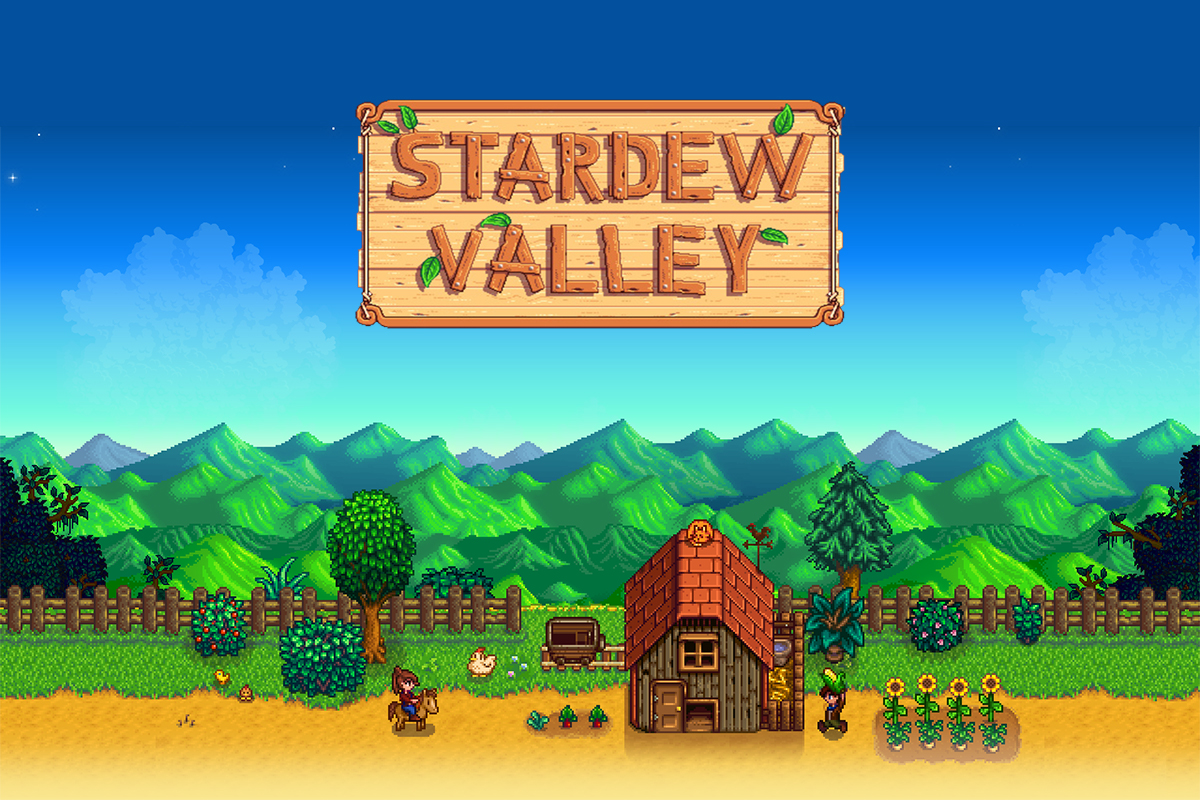
iThrive Curriculum game-based learning units are a set of social and emotional learning (SEL) curricular units for high school English Language Arts (ELA) and humanities courses that use video game narratives as core texts. In a previous post we outlined our approach to selecting games to serve as the narrative foundation for these units. In this article we'll illustrate how we applied this approach to assess the hit title, Stardew Valley, and why we ultimately decided not to pursue a Stardew Valley unit.
As we design any unit, we work closely with in-service and/or pre-service educators. In the spring semester of 2020 we worked with the students of our frequent collaborator, education and Universal Design for Learning expert, Dr. Gabrielle Rappolt-Schlichtmann of EdTogether. Her Harvard Graduate School of Education students were studying the role of emotion in learning.
We challenged Dr. Schlichtmann's students to design game-based mini-units that would embed social and emotional learning into ELA learning objectives. (This collaboration generated the core ideas for our unit, Sam's Journey, which uses the mobile game A Normal Lost Phone.)
One group of students chose to design curricular content around Stardew Valley, a hit game that's widely hailed as an emotionally touching, engrossing experience. The game is categorized as a farm-life simulator, meaning players simulate the process of maintaining a farm and building relationships with the townsfolk nearby. The game is open-ended in the sense that players have a lot of choice and agency in how to spend their in-game time and which goals to pursue. They can choose to specialize in trapping or fishing, for instance, and decide which animals to tend to on the farm, which produce to grow, and how much time to spend mining in the nearby caves. They can choose to run errands for the townspeople, and to pour effort into rebuilding the community or play a part in its eventual takeover by a soulless corporation.

A gameplay snapshot of Stardew Valley.
The draft unit that the students submitted for Stardew Valley was excellent. It was fully student-centered and focused on having students develop friendships with non-playable characters (NPCs), learning about their unique traits. The proposal was for students to tap into their empathy and perspective-taking to extend the characters' narratives through creative writing activities. These appeared to be solid angles from both an SEL and ELA point of view.
These aren't the only considerations we had to keep in mind, though. In the game, players start out as a novice farmer new to Pelican Town. They work for (in-game) days, seasons, and years to really understand what success in the game looks like and to make meaningful progress towards building relationships and contributing to the community. Members of the iThrive team have played for over 20 hours and still have a lot of work to do to get close to multiple NPCs and learn meaningful tidbits about their lives. The main drawback of Stardew Valley for our curricular approach is, ironically, the very mechanic that makes it an excellent springboard for discussions about relationship building: the time it takes.
The themes of integrating your character into the community and learning the unique traits, likes, and dislikes of your neighbors are a primary reason this game is powerful from a social and emotional learning standpoint. It just wouldn't do to rush students through the various components of the play experience just to "get to" the meaningful relationship-building moments; the drawn-out process is, in fact, the point. It takes sustained time and attention to build trust and reciprocity among community members.

A gameplay snapshot of Stardew Valley.
Another critical consideration that ultimately made us decide against pursuing a unit around Stardew Valley was a question of accessibility. The unit was designed for students to play the game alone so they could make choices that aligned with their interests and have the experience they wanted in a largely open-ended game. The game can be played on mobile phones, which is a boon to game-based learning since most teens have phones. But the game costs at least $5/license. That likely wouldn't be a barrier for a "hot seat" model of play — where students rotate playing in front of the class while peers observe — but for solo play the cost might be prohibitive for the many classrooms on tight budgets.
Here's a summary of our ultimate decision points around releasing a Stardew Valley unit:

A critical point in our decision-making process was to ask for feedback from one of our trusted teacher partners and game-based learning advocates. Our frequent collaborator, Brian Harmon, a high school ELA teacher in Georgia who uses multimedia teaching approaches, reviewed the unit proposal and noted that its biggest drawback was that "playing the game for 'hours' means we would need some formative assess[ment] component for every 15-30 minutes of gameplay. How many hours into the video game before characters are developed and how are the actual mechanics of the core gameplay addressed in the pedagogy? If the lessons are tied to the interactions only and not the gameplay then that could be a problem....The administration won't like the play, play, play, without a lot of doing (at least they won't at my school)."
All of this said, a teacher devoted to project-based, community-building efforts certainly could make Stardew Valley gameplay and discussion a recurring experiential component and discussion point of an entire semester or year-long course. But generally we have found that the more time-limited and contained gameplay experiences like those found in emotional hard-hitters including What Remains of Edith Finch and A Normal Lost Phone better deliver a feasible game-based SEL option for high school classrooms.
Are your teen students or kids already playing Stardew Valley? If so, use our game guide to connect with them about the social and emotional learning themes the video game touches upon.
Some additional questions to pose to Stardew Valley players to support critical SEL reflections:
- Among the NPCs, which ones are you drawn to and why?
- What are you noticing about your own biases and first impressions towards NPCs in the game?
- How is the culture of this community similar to or different from yours?
- How do you see your community members supporting one another in real life?
- What unique talents and points of view do/can you contribute to your community?
- How do you build relationships?
Engaged Students, Engaged Citizens: iThrive Content Now on Composer

We are thrilled to announce that iThrive Curriculum: Sam's Journey is now available on Composer—a place for educators to access the top citizenship education resources from around the world and to integrate learning science into curriculum planning.
Sam's Journey is a humanities unit that invites students into a uniquely told story using digital artifacts, examining how different modes of communication are used to express identity, thoughts, and feelings. Based on the digital game A Normal Lost Phone, students explore the question of identity and gain insight into the experience of a youth in the LGBTQ community, all while adhering to the core standards educators need to meet for high school English Language Arts classes.
We are happy to share this content on Composer, as the organization's focus on citizenship education aligns with our values at iThrive. Citizenship education empowers and supports students in becoming better citizens through the teaching of civic learning, social justice, social and emotional learning, and global competence.
Our content joins 1,000 learning experiences available on this new digital platform, free for educators to access the top citizenship education resources from around the world and design high-impact curriculum for middle and high school students. Our other English Language Arts unit, iThrive Curriculum: Museum of Me, will be available on Composer later this month.
To pair Sam's Journey with LGBTQ-oriented lesson plans from other organizations, sign up for Composer today.
#EdChat: The Importance of Universal Design for Learning (UDL)

At iThrive, Universal Design for Learning (UDL) is a key design element in all of our curricular units. Whether we're creating content for high school English Learning Arts or civics courses, we collaborate with UDL experts at EdTogether and use the principles of UDL to design the delivery methods, activities, and assessments that comprise each learning experience. In designing our units, we consider the diversity and variability inherent to the teens involved and work to prepare the learning environment to be rich with options for how teens take in the experience and how they express their new knowledge and skills.
Each teen develops differently and engages with concepts from different access points. The best learning happens when students engage authentically from the entry point of their own curiosity, interests, strengths, and ideas. That's a key reason we use game-based approaches. Games provide immersive experiences that offer visuals, sound, and movement to ensure students can engage in learning in multiple, embodied ways.
Using a game is a great initial step toward universally designed learning experiences. As you make choices about which game-based learning units to use with high school students, consider these three reasons to ensure that UDL principles were used during the design of all the curricular elements.
- UDL is a student-centered approach. A UDL orientation prioritizes students' authentic engagement and places a high value on their agency and use of unique strengths. This is an approach that resonates with people of all ages, of course, but is especially critical for teens. We know teen students learn best when their experiences and identities are validated and respected in the classroom.
- UDL promotes flexibility and innovation. Approaching learning with a UDL frame makes us ask, "What's the real goal here?" If the end goal of a particular task is not reading comprehension, per se, but instead understanding a specific concept, why would we offer reading as the only method of engagement? UDL sparks us to think more creatively about presenting multiple ways to present and engage with content so that students can use a range of faculties and strengths to grow skills and knowledge.
- Designing for the margins uplifts everyone. A key benefit of UDL approaches is that making learning more inclusive isn't only good for learners who need extra support. Research shows that designing for learners with the highest level of need improves learning processes for all students.
Whether you use our iThrive Curriculum game-based curricular units, iThrive Sim game, resources from another educational organization or design your own, make sure UDL is part of the design to ensure that the unit takes into consideration the rich diversity of strengths and learning needs of your students.
How to Choose a Video Game for Learning in HS English Classrooms

iThrive Curriculum is a set of units for high school English Language Arts (ELA) and humanities courses that use video game narratives as core texts. It's one way that we support teachers in connecting meaningfully with their students where they are—playing games—to build social, emotional, and academic knowledge and skills.
Video games are a defining narrative form of this era. Their complex characters, compelling settings, and unique storytelling strategies are more sophisticated than ever and deserve the level of analysis teachers regularly apply to literature.
Of course, there are many types of video games and some are generally better suited for this curricular approach than others. When we partner with educators and teens to design transformational game-based learning units for ELA and related courses, here's what we look for in a game:
- Emotionally impactful and appealing to teens. We keep an eye on what teens are playing. Games that are already popular with teens can be a fantastic opportunity to meet them where they are and take learning deeper. On the other hand, some games are epic and award-winning but don't yet have a huge following. So we also look for opportunities to design around powerful indie games that are relevant to teens, like Accidental Queens' A Normal Lost Phone, featured in our unit Sam's Journey.
- A strong tie-in with social and emotional learning (SEL) competencies. We look for games with narratives and themes that naturally prompt discussion and reflection around social and emotional skills including self-awareness, identity, empathy, relationships, perspective-taking, purpose, decision-making, and more, because we know social and emotional skills are critical for teens' learning, well-being, and achievement now and throughout adulthood.
- A strong academic tie-in. To be a candidate for iThrive Curriculum, a video game narrative has to be relevant to specific learning objectives that teachers already need and want to teach. Our units highlight aspects of games, like narrative structure and literary devices, that support students' core literacy skills and also provide ample opportunities for them to listen, read, discuss, write, and create to express themselves and their learning.
- Attention to diversity of learners. We look for games that can engage all students in narrative analysis, even those who haven't always experienced success with reading. Games generally do this well because they offer visual context and immersion, making the narrative easier to engage with and understand. Some games do this exceptionally well; in What Remains of Edith Finch, used in our Museum of Me unit, the text of the narrative appears on screen in response to players' movements via the controller, and every word is narrated through a voiceover so students are interacting with the story through sight, sound, and movement.
- Mindfulness about diversity of experiences. We seek games that convey a wide range of experiences to ensure that diverse and often marginalized backgrounds, experiences, and characteristics aren't ignored and absent from the classroom. We strive for our units to support empathy around stories that depict diversity of race, language, culture, gender and sexual identity, ability, and more.
- A low-stress addition to the existing curriculum. Using a game instead of a text is much more likely to happen if implementation is made easy. We like to ask ourselves:
-
- What equipment will be required to play the game in or outside of class? Games that work on mobile, PC, or in web browsers usually are a lighter lift for implementation than those that require a gaming console. But students' and schools' varying access to the internet also needs to be taken into account.
- How long does the game take to play? Games that are relatively short (1-3 hours) tend to keep the scope of the unit manageable, although longer games used in part or in whole can certainly work.
- Does the game's narrative branch a lot? In narrative games with little or no branching (fewer choices for students to make while they play), it will arguably be easier for the class to have a shared experience even if they don't or can't play together at the same time. It will also be simpler for a teacher to figure out where students are in the experience and what's coming next.
- How many copies of the game are needed and how much does the game cost? Sometimes only one game license is necessary, like in the "hot seat" model, where one student at a time plays and the rest of the class observes. This works really well for games without much player choice. For games where individual player choice is a key feature, multiple licenses might be best but could get costly.
Ninety percent of teens play video games, and they're a culturally relevant way to engage students in their holistic learning. We hope the criteria here can guide you in considering how game-based approaches might work to support literacy and engagement in your ELA or humanities classroom. Ready to try game-based learning? Museum of Me and Sam's Journey are classroom-ready units with opportunities for social and emotional learning baked in, so be sure to check them out.
Do you have a great idea for a game-based social and emotional learning unit for high school humanities courses? Tell us about it at contact@ithrivegames.org.
Announcing New Game-Based Unit Created for Distance Learning
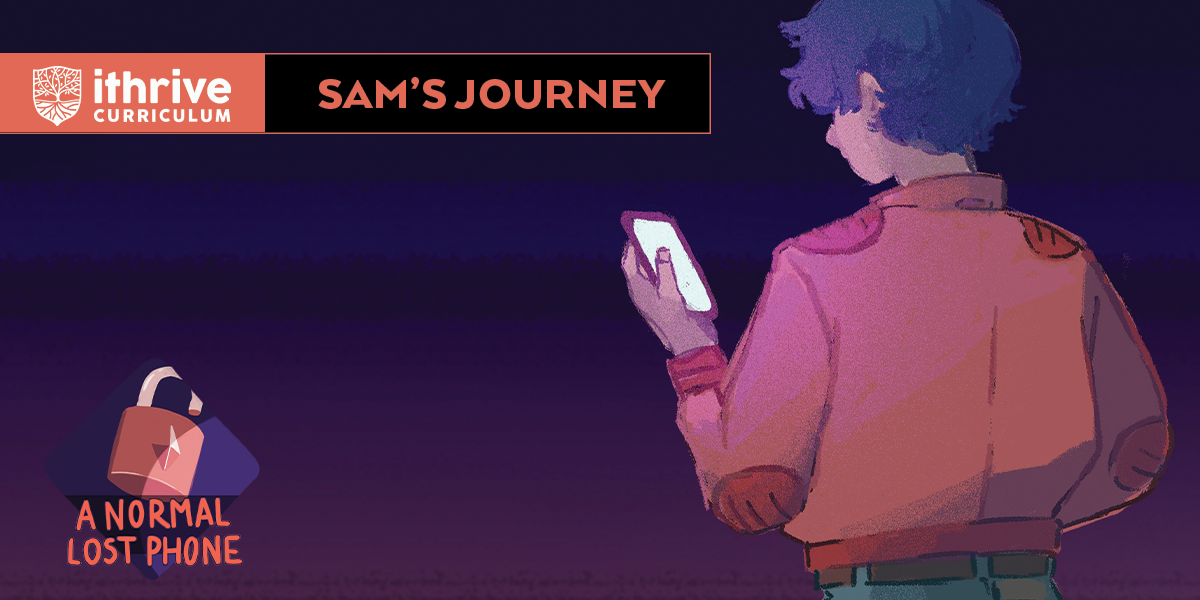
We know that now, more than ever, teachers need tools that support distance learning and encourage engagement and connection. iThrive Curriculum: Sam's Journey, a game-based social and emotional learning unit for high school humanities classes, responds to this need and is now available.
We are so happy to announce the release of iThrive Curriculum: Sam's Journey. Teachers who want to have engaging online sessions with students will enjoy this rich, concise unit. The game-based unit is designed for distance learning and can be used with 11th and 12th-grade students to explore self-expression and communication in relationships through the lens of digital and non-linear narratives.
Using the game A Normal Lost Phone, developed by Accidental Queens, as a text, students will undertake a narrative investigation, piecing together what happened to the game's main character, Sam. At the same time, they will encounter rich opportunities to reflect on and discuss how they express their identity in their own relationships using contemporary communication tools.
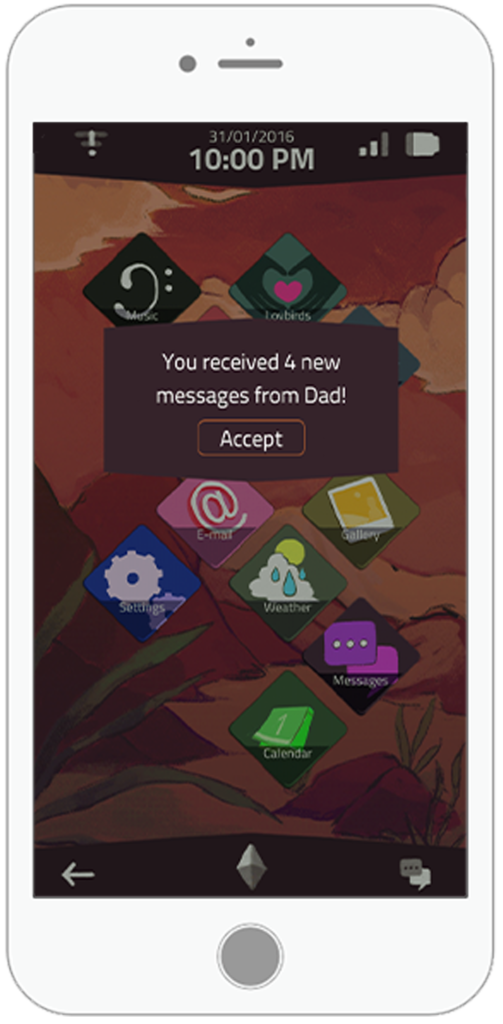
The three-lesson unit meets English Language Arts standards and social and emotional learning goals and is ideal for distance learning. It includes activities, discussion prompts, homework assignments that encourage self-reflection, and grading rubrics. The unit was created in collaboration with Jennifer Guerin, Kathleen Moore, Sophie Rich, Julia Wareham, and Jordana Weiner, students from the Harvard Graduate School of Education.
Dr. Gabrielle Rappolt-Schlichtmann, Kristin Robinson, Dr. Paul Darvasi, Dr. Shawn Clybor, and high school students from Dwight-Englewood School also made important contributions.
We look forward to sharing Sam's Journey with educators who are looking to close out this school year or enrich next year with a short game-based unit that will capture their students' imaginations. Contact us at contact@ithrivegames.org to receive a copy of the unit.
To stay updated with our latest game-based learning tools for high school classrooms and resources for distance learning, subscribe to our monthly newsletter here.
How Game-Based Learning Can Take Your Class to New Heights
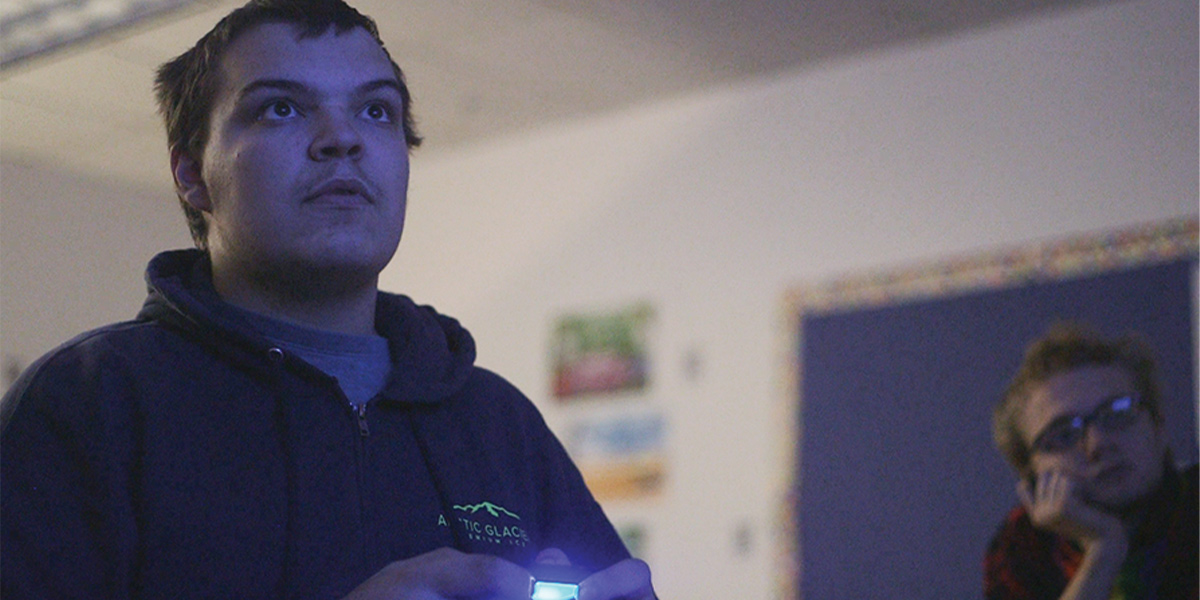
Our game-based learning units were designed to boost engagement and invite creativity in the classroom, virtually and in-person. Here's how integrating games in your classroom can take student learning to new heights.
This moment poses the opportunity to reimagine education. At iThrive Games Foundation, we partner with educators to create new possibilities for learning, whether that's in a physical classroom or a virtual space as we navigate COVID-19. We are inspired by educators who are finding ways to work games into their curriculum, affording students the opportunity to find relevance, engagement, and meaningful connection in their learning.
To help educators offer the best possible learning experiences, we create game-based curricular units that weave together the three things we care about the most: teen thriving, the power of play to support that thriving, and rich opportunities for social and emotional learning.
Deepen engagement in your learning environment through these five elements of our approach to game-based learning:
1. Impactful play: By designing school lessons around video games-a medium that teens are already interested in-we drive innovative thinking and meaningful connection by inviting teens to explore who they are and the world around them in a low-stakes but thought-provoking environment.
2. Deep learning: Many games present opportunities for students to interact with narrative in a completely new way, opening their minds to the storytelling techniques and opportunities all around them in today's digital communication landscape. We design our units around games with rich and creative narratives to invite teens to access texts in new and inspiring ways and to stoke a love of learning.
3. Personal transformation and growth: Games can transport teens to new worlds, enabling their exploration of new places and possibly, new versions of themselves. Curricular units that use games as a text can support students in writing about and reflecting on these explorations.
4. Social and emotional skills: Games stand apart from other media because players of games have agency — and even complicity — in the stories games tell. Since games can provoke feelings of frustration, pride, guilt, elation, forgiveness, and more, they're an incredible tool for supporting teens' social and emotional development.
5. Universal design for learning: Games are an excellent tool for engaging students who are left behind in the classroom due to issues of engagement or accessibility in more traditional learning approaches. Principles of universal design for learning also inform the activities and assessments that comprise our game-based lessons, acknowledging that each teen develops differently and engages with concepts from different access points.
Interested in integrating games in your virtual classroom? Check out our library of game-based learning units and download them at no cost here.
Game-Based Social and Emotional Learning for High School English Class – Part Two

A couple of weeks ago I introduced in an article, Museum of Me, our game-based social and emotional learning curricular unit for English language arts using What Remains of Edith Finch. In case you missed it, you can read all about the details of how we used this game for identity exploration here.
Paul Darvasi, lead creator of Museum of Me, and his high school English class at Royal St. George's College in Toronto were the first ones to complete this unit. The students, all in their final year at the all-boys high school, graciously shared with us their thoughts on the unit as a whole, the game, and their identity explorations. Here are some of their overall impressions of the unit and the activities they completed both in- and out-of-class:
- "This unit was a new and interesting experience I had never done in any classes. I was always very excited for this class due to its nature of new topics and activities."
- "I would describe my experience with this unit as overwhelmingly positive. It allowed for more creative work both in and out of class than almost any other unit I had ever been in. It had strong academic value while also being fun and interesting."
- "It was cool to think about my own identity formation and what objects/moments have attributed to who I am.
GAME-BASED LEARNING: WORTHWHILE TO TEEN LEARNERS?
Gameplay offers an innovative and currently underutilized way to deeply engage students and support them in learning and practicing fundamental social and emotional skills. By using a medium that teens are already excited about, we are able to drive innovative thinking by allowing teens to explore themselves and the world around them in a safe, thought-provoking environment.
Since games are a medium seldom used in the classroom, we wondered if students found the game-based unit relevant and meaningful to their learning. Many of the students felt excited to be able to use a medium that they are interested in already and they also enjoyed the attention-grabbing plot and quality of What Remains of Edith Finch. They told us how games enable them to engage and encounter new experiences that they wouldn't otherwise be exposed to.
- "I think that using games in learning is pretty cool because it is something that everyone our age is familiar with and can use pretty well. It also allows for each person to have their own experience and can learn the way that they feel is best for them."
- "I think most teenagers enjoy playing video games, so when implementing it into school they actually become eager to do their work and will perhaps learn more."
- "They [games] promote a stronger feeling of connection to the educational content that is being shared. Personally, I felt more engaged during class as I was constantly interested in the game material."
- "I think that games are important in learning as they allow someone to explore knowledge in a way that isn't just reading from a textbook or watching a video. I find it very interesting to be able to learn interactively, in-fact I find that I absorb more knowledge in a game than in a textbook."
INDIVIDUAL VERSUS GROUP GAMEPLAY
Throughout the unit, students played What Remains of Edith Finch as a group, which in this case meant one student had the controller while the others watched the gameplay unfold. Students alternated who had the controller during and across each class period, and observing students made requests of the student in control throughout gameplay.
We weren't sure how the students would feel about this experience, as we know that impressions can be very different when watching someone play a game versus actually playing it yourself. We were curious about how students responded to the group play structure, and whether this hindered their learning or expanded it. Overall, students were supportive of the group gameplay, for a variety of reasons, although some definitely wanted to be in control.
- "I think that it doesn't make much of a difference for a game like Edith Finch because it is more like watching a movie, unlike something like Call of Duty where it's more skill-based and is boring to watch if you're not playing. It is sometimes nice because you can just sit back and enjoy the game."
- "It was like watching a movie when others were playing, but more engaging because you could tell the player what to do. I think that it is enjoyable watching, but obviously more enjoyable playing, but also shouldn't really be changed because we were still engaged."
- "It is interesting to see where other people chose to search as well as how others who are not playing interact with the person using the controller."
- "For me it was fine. Obviously I would like to have full control (I actually didn't even play once!) over the game but watching worked as well. It was interesting to see what decisions my classmates made and compare that to the ones that I would have made."
- "It was slightly irritating, as it is not as an enjoyable experience watching someone else set the pace for exploring the game."
- "Edith Finch is a very visually appealing game so there was no problem with me stepping back and observing due to the beautiful graphics. This, in turn, engaged me more as a backseat observer."
OPENING UP ABOUT ONESELF IN CLASS
Students shared with us what was most compelling to them about the thinking, learning, and creating they did during the Museum of Me unit. They really appreciated the class discussions and having the chance to share personal stories with their peers. Some admitted to taking a little more time to warm up to the idea of being personal, but once they did, they expressed how much they learned not only about themselves but about their classmates as well.
- "I really liked the final Museum of Me project at the end of the unit. It took me a while to be comfortable, but in the end I enjoyed working on it."
- "Okay, it was a little uncomfortable being that personal, but by the end of the unit it was fine."
- "I think I did learn a lot from the meme one not only about myself but about other people based on how they view themselves and how they think others view them."
- "I found it allowed us to express ourselves in ways we usually can't."
- "I think this unit builds over time in a very unique way. It starts slowly with a series of simple worksheets and whatnot and it slowly evolves until you reach the Museum of Me assignment. In this latter half is where I think the majority of the learning occurs and is also where 100% of the creativity comes into play. So overall it was very strong on both counts."
- "The promotion of a more personal connection to the unit. No teacher has ever attempted to combine personal with curriculum and it was a pleasant surprise. It allowed me to develop a more emotional connection to the course material."
UNDERSTANDING IDENTITY
One of the key areas of focus in our Museum of Me unit is exploring identity and how our identities are shaped by those around us. We wanted students to think about the roles that they play in school and at home, and the ways that the labels and masks they put on (so to speak) reflect those identities differently. We asked the students, "How did your understanding of identity — both your own and others' — change over the course of the unit?" And here is what they had to say,"I think my understanding of myself definitely changed a great deal, through the Museum of Me project I was able to deal with some aspects of myself that I never really had before. Also through talking about the projects I learned about my friends too."
- "I really noticed how much other people have an effect on one's identity."
- "In terms of understanding my own identity, it changed in the sense that I became more aware of what things have helped to form my identity. I was not aware of just how many items/people/moments have had an effect on my identity formation."
- "This unit really pushed me outside of my comfort zone and took a look at myself. I normally don't talk about myself this much, and this gave me some new retrospect on how I view myself."
- "During my identity of me assignment, I realized how much of my identity was created by my parents when I was young but as I began to grow up, more of my identity is shaped by my friends and my personal choices."
- "I learned a great deal about myself in the construction of it and definitely felt that I knew myself better on the other side."
THE FINAL PROJECT: DESIGN YOUR MUSEUM
The Museum of Me unit ends with a culminating project where students design an autobiographical exhibit to explore their own identity formation. Each student curates a collection of artifacts which may include pictures, letters, journal entries, quotes from role models, and more. Students create narrative labels for each artifact describing its relevance to their own identity journey and they are given free reign for the format of their museum. Some students with Darvasi's class created interactive narratives using Twine while others created journals or interactive, physical objects. Here's what they had to say afterward:
- "The most compelling part of this unit for me was the Museum of Me project. I had to think about myself as a person and what things attributed to my identity formation."
- "Museum of Me was particularly appealing, I found that I was willing to fully invest myself into the project and received greater satisfaction from the final product than I usually do with other projects."
- "I liked Museum of Me because it allowed me to look back into my past and speak about how it formed my identity."
- "Museum of Me project because it allowed us to take our own path and create a fun final product that was enjoyable to make."
- "Museum of Me was absolutely the most enjoyable simply for the fact that it allowed for so much creativity and exploration which is both fun and very intellectually stimulating."
- "I learned most from the Museum of Me project in terms of social/emotional intelligence and learning. I learned how games can be used to tell stories and used to connect with students as well as how they can be used to reflect upon your own life."
- "The most recent assignment, Museum of Me, was the most enjoyable assignment because I got to use things that are part of my identity and showcase them in a portfolio type style of online pictures to show the class."
FINAL THOUGHTS
We designed the Museum of Me unit as a demonstration project to showcase how games can be integrated into meaningful classroom learning in a way that provides engaging and collaborative discussions with teens. The pilot run of the unit showed us that students found it to be both enjoyable and interesting. Even more important, they said it gave them the ability to learn not only a lot about themselves but their peers as well. And, they even said it was cool! (whew!)
- "That it's creatively stimulating and promotes insight on personal identity; as well as, innovation within the classroom. It's important for boys, in particular, to reflect and understand their emotions and learn more about how identities don't reflect everything about you."
- The majority rated it as the best unit they've ever had! And with this sign of support from our most important audience, onward we go to create more game-based units for high school students!"
JOIN US!
If you would like to use the Museum of Me unit in your classroom, download and learn more about the unit here.
Sign up for our newsletter so you can stay up to date on the release of this unit and all the other incredible happenings here at iThrive Games! You can also check out our previous blog on all of the resources we have available for educators and using games to engage the whole teen.
Game-Based Social and Emotional Learning for High School English Class

(Yes, it is possible!)
iThrive Games works to benefit teens at the intersection of game development, education, and mental health. That is why I was so excited at the opportunity to partner with Paul Darvasi, a teacher at Royal St. George's College in Toronto and Matthew Farber, an assistant professor at the University of Northern Colorado's School of Teacher Education, in creating Museum of Me, a game-based learning unit involving Giant Sparrow's, What Remains of Edith Finch.
Developer: Giant Sparrow
Social and emotional learning (SEL) encompasses educational strategies that support students in developing and practicing their social and emotional skills. This includes everything from self-awareness to responsible decision making to relationship skills. Games offer a unique opportunity to support SEL in high school classrooms, where teens need more challenging and realistic content and engagement than the practices used in elementary classrooms. Games help transport teens to new worlds, enabling their exploration of new places and possibly, new versions of themselves. As the Guardian wrote in its 2017 review, "What Remains of Edith Finch is a game that succeeds in recreating the childhood joy of reading a book and being utterly transported into its pages, only to reach the end and realise it's not real."
In talking with EdSurge recently about Museum of Me, Paul Darvasi commented, "Schools are very emotional places that don't invite emotion, and that is a big problem." Many games present challenges that require players to adapt and grow in ways that promote deep learning and self-awareness, allowing players to experience a broad range of emotions. Feelings of betrayal, guilt, forgiveness, frustration, pride, and so much more, can be felt while playing games making them an incredible asset for teen's social and emotional development.
How We Created Museum of Me
I was looking for a game-based learning project for iThrive and knew we needed a special game that would authentically invite teens to explore their own emotions alongside a compelling character study. Paul and Matt knew they wanted to create a classroom unit for What Remains of Edith Finch almost immediately.
What Remains of Edith Finch is a game that follows a girl who is exploring the history of her family through the home that she grew up in. The game invites players to a safe place to explore and learn, while also leaving them feeling humbled and mesmerized by the vast world around them. There's so much in this game for students to immerse themselves in, (thank you, creative director, Ian Dallas, and the team at Giant Sparrow!) and that inspired us to design a teaching unit that would measure up. Matt believes that video games are the "storytelling mediums of the 21st century," and in that spirit, Museum of Me gives students and teachers a way to discuss identity and build on social and emotional skills that are of grave importance beyond the classroom.
GBL + SEL + ELA + UDL
We embraced the rich interactive narrative of What Remains of Edith Finch and knew it would be an ideal catalyst for a game-based learning (GBL) unit on identity exploration, one of the pillars of the resilience framework for SEL, cited and used by iThrive advisor Dr. Rachel Poliner. To design the learning objectives underlying the study we gave equal weight to the game, and standards for both English Language Arts (ELA) and SEL. We landed on a set of learning objects that include exploring identity and character, comparing and contrasting public and personal narratives, examining how possessions represent and maybe even misrepresent aspects of identity and reflection on self.
We used the principles of universal design for learning (UDL) to design the activities and assessments that comprise the lessons. We worked hard to make sure our design choices took into consideration our understanding that each teen develops differently and engages with concepts from different access points. It was very important for us to create opportunities to engage all students deeply in a compelling learning experience, driven by their own interests and ideas. Learning scientist and universal design for learning expert (and an advisor on the unit), Dr. Gabrielle Schlichtmann of EdTogether remarked, "The curriculum authors have worked to build a flexible experience so that teachers can meet the needs of all students - there are many ways for students to access the content, show what they know, and engage in deeper learning."
The Museum of Me's multi-method assessments happens when students create artifacts both in and outside of class. In one assignment students read "Chameleon" and reflect on their own relationship with an item of clothing or some other status-oriented possession that projects identity. They then create two 30-second vlogs introducing two items that express their identity or that are attached to a meaningful personal story. One vlog is to be public-facing and the other is to be private. As students analyze the process of creating publicly- versus privately-facing vlogs, they consider what identity is and how might its expression change depending on the audience.
Students also create memes, based on the one below. They select photos to represent how they see themselves, and how they think their friends, family, teacher, and others see them. Dr. Schlichtmann said of the meme project, "I love this assignment - it is authentic and relevant. I also think that this humorous format can dampen discomfort students might feel."
Not Sure Where to Start with GBL in Your Classroom?
If you are interested in using games in your high school classrooms, check out this video about why educators are using games in their classrooms and our game-based learning guide for some tips to get you started. Also, be sure to check out this great article from our archives by Barbara Chamberlin and Jesse Schell for other terrific pointers.
Join Us in Piloting Museum of Me
If you are interested in trying out the Museum of Me unit in your classroom or after school program, contact us for an early release version.
Let Us Know How You're Using Games with Teens
I love to see games integrated into engaging and collaborative discussions with teens. Gameplay offers an innovative and currently underutilized way to deeply engage students and support them in learning and practicing fundamental social and emotional skills. By designing school lessons around a medium that teens are already interested in, we are able to drive innovative thinking by allowing teens to explore themselves and the world around them in a safe, thought-provoking environment. What will you create? Be sure to let us know — we'd love to feature you on our site!
Sign up for our newsletter so you can stay up to date on the release of this unit and all the other incredible happenings at iThrive Games!
If you want to learn more about game-based learning, check out Matt's recent books, Game-Based Learning In Action, and Gamify Your Classroom, both published by Peter Lang Inc.
iThrive's Senior Director of Learning, Michelle Bertoli, has been invaluable in forging our collaboration with Paul and Matt and supporting their efforts. She's blissfully enjoying her maternity leave and will return in the Spring.
__________
ABOUT THE AUTHOR
Game-Based Learning in the Classroom: 3 Essential Questions
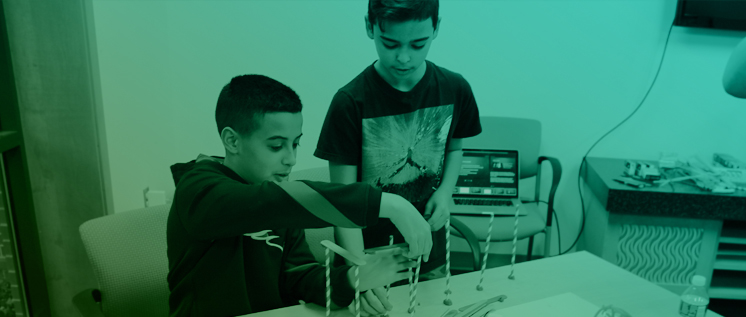
Because games teach in ways that are unique, they bring many interesting affordances to the classroom. Games give learners a chance to immerse themselves in new information, apply that information in problem solving, and take new perspectives. They offer exposure to new content, and ways to practice tasks. Students can fail safely in games, and they can experiment with different types of solutions. Games allow students to work in self-directed, independent ways, and also on collaborative teams. There are some great strategies for finding games, involving your learners in selecting games, and helping students reflect on their gameplay, in a previous post on the iThrive Games blog by Barbara Chamberlin: Meaningfully and Realistically Using Games in Your Classroom.
We've seen games used in different ways in classrooms. The simplest way to use them is as a time filler on the computer in the back of the room for students who finish work early. If you just need a way for students to fill their spare time, using games is easy. Point your learner to the computer, give them some suggested sites (such as BrainPOP's GameUp or Games for Change), and game on!
[Related: iThrive's Curated Games Catalog features titles that may support teens' social and emotional skills including kindness, curiosity, empathy, and growth mindset.]
While the time-filling game model is fine as a starting point, we love seeing games integrated as more engaging, collaborative, and long-term immersive experiences. Ideally, gameplay is used to help students learn, not just to help them practice. Game-based learning offers the most to students when it is consistent with the other educational practices of the classroom. As instructional designers, teachers use several different tools to teach, but the tools should align with how learning happens. As with all educational technology, the most important decisions have little to do with the medium and everything to do with the what is being learned. More specifically, we need to think from the learner's perspective.

The 3 essential questions for incorporating game-based learning in the classroom. Image source: Authors.
Game-based learning can be guided in the classroom with three key questions (Note: These questions are based on the three-part framework we have created for the development of educational games. This process also adapts beautifully for developing a game-based learning model for using games in classrooms):
- What change do I need to see in my student?
- What kinds of activities will help create that change?
- How can games facilitate those activities?
What Change do I Need to See in My Student?
It's easy to think about what we need to teach someone, rather than focusing on what they need to learn. Of course, learning is only one kind of transformation. Our students may just need to learn content, but it is more likely we also want them to change their behavior, increase their skills, or connect emotionally to something they are learning. It's likely we need them to change in more than one way. There are five key types of change we might want to promote in students:
- Knowledge: What they know
- Skill: What they can do
- Behavior: How they act
- Emotion: How they feel
- Physiology: How they are
As educational designers, it helps us to think about what happens in the classroom as multiple types of change, rather than just knowledge gain. For example, for a unit on civics, we might want students to...
- learn facts about the way our government works (knowledge change)
- identify ways in which they can make changes in local, state, or national government (skill change)
- try to influence government for the kind of change they want to create in the world (behavior change)
For a health unit, we might want them to...
- understand caloric balance and different types of nutrients (knowledge change)
- prioritize daily physical exercise (emotion change)
- increase their cardiovascular capability (physiology change)
These types of change are based on where are students are now, and how we want them to be after our lesson. What knowledge and attitudes do they already have? What misconceptions do they have? How will they be transformed? If we can answer those things, the next step is to think about what they need to do to make that change.

Kids learn content from games, but they also learn by the way they play games. When they play collaboratively, they benefit from social learning strategies. Image source: Authors.
What Kinds of Activities Create that Change?
We each like to learn differently. We watch, listen, read, and absorb information. We practice, memorize, and rehearse different facts or phrases or activities. Change can come from a range of different activities, but the important thing to remember is that all change ultimately comes from doing. For this reason, thinking about which types of doing will most help your learner is very important. For example, in a project-based lesson about different states of matter, students might...
- absorb information
- discuss what they learn
- form hypotheses
- test those hypotheses
- reflect
- re-hypothesize
Each of those activities brings about some amount of change in a student, but all of them work together to create more significant and lasting change.
Students engaged in learning technical writing may...
- familiarize themselves with different rules for grammar and punctuation
- practice applying those rules in different types of writing
Learners on a field trip may...
- experience wonder and surprise while learning about animals
- be challenged to rethink something they feel should be true but isn't
Creating lists of all the different types of activities that learners go through can be challenging, but it helps to just think of the verbs. Given the content, process, or change you want for your learners, how do you believe they are most likely to achieve that change? What kinds of things do they have to do to go through that change? Again, it is likely to be not just one, but several different kinds of activities.
How Can Games Help with Those Activities?
The third logical step is to use games to facilitate those activities that bring about change. We look forward to one day finding a clearinghouse with thousands of games that address all of the different kinds of learning our students do...but we just aren't there yet. The good news is that wonderful games are already available and new ones are being released every year. The kinds of games that engage students in deeper learning experiences can take a considerable amount of time to build. Quick, quiz-like games are fairly easy to make — and accordingly, to find — but may not offer richer learning beyond helping students memorize facts.
The challenge for teachers is to find the games that best encourage the activities that will impact learners the most in a way that matches their educational approach. Quiz and reward games teach students how to memorize facts, but they don't help students do, explore, question and apply the content. In implementing games in your classroom, there must be a match between your content and the way in which you want your students to learn.

In Night of the Living Debt, players succeed (and fail) at raising their credit score. Image source
For example, several different types of games offer content regarding financial literacy. Night of the Living Debt, an iPad game we developed at NMSU's Learning Games Lab, is designed to help students understand how a credit score works. The content behind the game is fairly basic: it includes what types of activities impact your credit score (paying off a credit card, being late with payments, taking out certain kinds of loans), as well as what types of things are impacted by your credit score (loan rates, housing opportunities). What is unique about learning this content through gameplay is the way in which the learning occurs. In the game, students are allowed to experiment with different activities, getting immediate feedback regarding their credit score. They are allowed to fail and try again. The developers believe that this kind of learning is more likely to impact players' future behavior, than if they were simply exposed to the content by reading a list of credit score influences, or if they were quizzed on what types of activities affect credit score. How the students learn in the game is as important as what they learn.
If you can articulate these ideal ways to learn, your next step is to find a game that teaches with similar approaches, and supplement the game with additional activities. You might find a game that introduces content, but then you might add lab activities that allow students to apply that content in new ways. On the other hand, you might have students learn content on their own through their books, then use open-ended gameplay to help them apply it in ways that are difficult to do in a classroom.
Good educational games address content and introduce players to different ways to learn. When a good educational game matches your educational approach, you have a seamless and effective way to use game-based learning to its greatest advantage.
* * *
About the Authors

Barbara Chamberlin, PhD, oversees research and development at the Learning Games Lab at New Mexico State University, a non-profit educational production studio. She has a passion for user testing, math and science education, and hands-on learning. Her current projects include apps for pre-school students on physical education and healthy eating, chemistry learning tools for college students, and pre-Algebra games for middle school students. Learn more about her work at learninggameslab.org.

Jesse Schell is the CEO of Schell Games, a team of one hundred people who strive to make the world's greatest educational and entertainment games, including Yale Medical's PlayForward: Elm City Stories, Water Bears VR, SuperChem VR, the Daniel Tiger's Neighborhood games, and Happy Atoms. Schell Games also creates pure entertainment content, such as the award-winning VR game, I Expect You To Die, and the comedy space game Orion Trail. Jesse also serves as Distinguished Professor of the Practice of Entertainment Technology at Carnegie Mellon University. Jesse has worked on a wide variety of innovative game and simulation projects for both entertainment and education, but he is best known for his award-winning book, "The Art of Game Design: A Book of Lenses," and his predictions about the future of gaming technology. He is a previous chair of the International Game Developers Association, and former Creative Director of the Disney Virtual Reality Studio.
An Interview with Kinful: Bringing Cross-Cultural Empathy to Schools with VR

How do we prepare today's students to thrive in an uncertain world? One proven technique is for schools to wholeheartedly support students' social and emotional development — their empathy, their ability to bounce back after failure, and their capacity to connect meaningfully and sensitively with diverse people across the world. Schools are demanding effective social and emotional learning (SEL) approaches now more than ever, and Michael Auerbach and Sam Williamson, co-founders of Kinful, are two of the visionaries rising to meet the need.
The Kinful curriculum is designed to build five key social and emotional skills in students from elementary through high school. Among SEL programs, one really unique thing about Kinful is that it leverages the power of virtual reality (VR) to empower students to connect in meaningful and empathy-building ways across geographical boundaries.
Students in Kinful classrooms — so far in New Jersey, New York, Texas, Washington, South Africa, Turkey, and soon the Ukraine — create 360-degree videos to share their daily activities, interests, thoughts, and feelings with peers across the country and the world. iThrive caught up with the Kinful team to find out more about their inspiration, their successes and obstacles, and their hopes for the future of the program.

Students using Kinful's VR headsets react to 360-degree videos created by students from another country. Image source
iThrive: You have shared that Kinful's mission was inspired by your Peace Corps service. From there, how did you decide to use VR in schools to support cross-cultural empathy?
Kinful: Peace Corps exemplifies a powerful aspect of humanity: the innate ability of humans to empathetically connect with one another despite vastly different cultural backgrounds. Peace Corps volunteers and host-country nationals instinctively laughing together, crying together, and caring for one another highlights how empathy can transcend cultural boundaries. The idea that empathy is the thread that binds humanity together is a central inspiration for Kinful.
We knew we needed active engagement, as opposed to passive engagement like watching a documentary, in order to recreate the Peace Corps experience in the classroom. The immersive aspect of VR provides the exact type of active engagement needed!
iThrive: What are the key components of the Kinful curriculum?
Kinful: A typical Kinful lesson consists of non-sequential workstations where students rotate between activities. Half of the workstations are VR-related (viewing and filming), and half are "standard" SEL activities (e.g., teamwork games, group reflections, etc.).The VR and the 360 filming activities within that rotation are fundamental to Kinful's vision and impact, but they make up only a portion of the greater Kinful whole. The tech and non-tech activities support and extend each other. As students move from one workstation to the next, they experience and reflect on SEL themes individually, in groups, and through someone else's eyes (VR).
The Kinful kit comes with a range of engaging materials — including VR headsets — teachers can use to support students in building 5 key social and emotional skills. Image source
iThrive: What is it like when a student first connects with a peer from another place and way of life? What emotions do you see being shared, and what kinds of stories?
Kinful: It's all smiles when a student puts on a headset — but to be honest it's hard to tell if the smile is coming from the inherent delight in identifying with someone else in a different country, or if it's coming from the awe of using VR presumably for the first time. It's probably a little bit both, which is fine with us!
iThrive: What about after the connection — what do you see or hear from students? How do they talk about the experience?
Kinful: In an effort to get students to relate to one another, we always prompt students to share videos of universal experiences like spending time with family/friends or taking care of responsibilities. Of course, these things will look different across cultures, but the general concept is always recognizable and relatable.
From there, students usually come out of a Kinful video saying something like, "I eat lunch with my friends too!" or "I also have to do house chores after school!" These simple and universally translatable experiences help bridge cultures — moving us away from a more removed, academic understanding (fun facts of a foreign country) and getting us closer to a more personable familiarity ("Mohammed from Senegal loves walking his dog in the morning. So do I!").
iThrive: What has surprised you most about what students want to share with each other through the videos they create?
Kinful: What they want to share hasn't been particularly surprising (again, our prompts revolve around everyday stuff), but how they've been sharing has been surprising. By that, I mean their eagerness! I anticipated awkward hesitation in our students' first videos (probably because I could easily imagine my twelve-year-old self awkwardly talking about my Warren G CD or Green Day blacklight poster). But no — teachers tell us their students love filming themselves!
A student uses a head-mounted camera to create 360-degree video for Kinful peers around the world. Image source
iThrive: What's your biggest (or favorite) success story to date?
Kinful: Our biggest success story to date has been our adoption of "standalone" VR headsets, which are headsets with an operating system and screen built in. Prior to this adoption, we used a smartphone + headset setup to view VR videos through a Kinful app, which involved two central hurdles: 1) procuring a smartphone and 2) Wi-Fi connection to stream videos.
Standalone headsets solve these two hurdles because: 1) the price of a standalone headset is a fraction of the cost of a smartphone and 2) standalone headsets allow us to upload our entire VR library onto the device, bypassing the need for Wi-Fi to stream (smartphones typically don't have the capacity to store our library).
iThrive: What are some of the obstacles to extending the reach of a program like Kinful into poor and rural areas across the globe? What are some solutions you are using or planning to use?
Kinful: The biggest obstacle was internet access needed to view our VR videos. Our recent adoption of standalone headsets with our VR library preloaded has solved this problem. Now, we're able to send a Kinful kit to a partner site with everything needed to execute Kinful programming (VR hardware, activity supplies, etc.).

A student donning the Kinful VR headset. Image source
iThrive: What advice would you give a developer who wants to design tech- or game-based experiences that promote or support empathy?
Kinful: Our mission is to encourage students come to their own conclusion that what binds humanity together is greater than what divides us. We want students to watch these videos and notice the similarities they have with students from all over the world. Once those connections start being made, empathy naturally follows. That's why we've stocked the Kinful video library with universal, relatable experiences.
In that vein, we've thus far shied away from creating traumatic reenactments to promote empathy, like first-person angles of bullying for example. That's not to suggest we believe such a video would be ineffective — it's just that we've found students to be more open and vulnerable when engaging with less threatening material.
iThrive: It's no secret that it can be really challenging to get both SEL and tech-based programs adopted and implemented widely in schools. What obstacles have you faced and how do you get around them?
Kinful: The biggest challenge has been schools figuring out how to pay [for Kinful]. Most schools we've talked to don't have an SEL budget, but they do have a tech budget. Problem is, Kinful doesn't neatly fit into a tech category since we're not targeting tech outcomes. With our main focus being SEL, we've had the most success engaging with schools that already have SEL initiatives taking place.
iThrive: What advice would you give to a teacher who is uncomfortable using technology in the classroom? What about teachers who struggle with teaching SEL?
Kinful: The first bit of advice for a teacher uncomfortable with using technology or integrating SEL would be that there's no need to reinvent the wheel! There are a lot of high-quality resources out there that present best practices, materials, and tutorials for both.
We definitely wanted to try and get out in front of any potential unfamiliarity with tech or SEL by creating a curriculum that is largely student led. Teachers who are uncomfortable with tech and SEL have in Kinful a simple yet high-quality way to get started without the pressure of creating their own programming. With all materials and directions supplied, the teacher just stages the room and follows the steps to facilitate the lesson. We designed Kinful to be as useful to a savvy veteran teacher as it would an inexperienced summer camp counselor.
iThrive: What's your vision for what's happening at Kinful in 5 years?
Kinful: Kinful is ultimately building towards creating a global community of schools, an international network of students and educators discovering connections and growing together towards a more empathetic future.
However, as we've designed Kinful to be molded by students (prompts are open-ended, and we encourage students to film and share what matters most to them), we imagine that as the years pass they will change and shape the program, bringing us to a place we had never even imagined!
__________
To learn more about the Kinful curriculum, visit www.kinful.org and check out the team's orientation video for partner schools:
Meaningfully and Realistically Using Games in the Classroom

Practical barriers can keep the most enthusiastic teacher from using games in the classroom. Let's get real — and realistic — about ways to approach game-based learning for the classroom. Teachers are busy, and usually spend much of a given school day completing work from that day while simultaneously preparing work for the next day.
So how, then, do teachers find the games to use in class, play the entire game to understand what and how it teaches, and review best practices? Often, they don't. Here's a more realistic approach to using the power of game-based learning in the classroom.
Look for the Helpers
Game-based learning has gained enough traction in our learning communities that it is much easier than it was in the past to find both high-quality games and powerful resources on how to use them. The trick for teachers is to realize that these resources exist. Look for collections of educational games as well as specific guides for implementing game-based learning.
Collections of Games
My favorite clearinghouse of games is the free Game Up website offered by BrainPOP. These games are curated to share the best games currently available by a wide variety of developers, and the games are grouped by content area. The BrainPOP team aligns the games with Common Core and other standards and offers recommendations on how to integrate the games into instruction. While the games are free of advertisements, BrainPOP does provide links to related content in its subscription-based collection of videos. My team at the Learning Games Lab has placed several of the games we have developed into the collection.

Other free collections also offer a range of games. Games for Change offers recommended games on different content, from typing to math to social justice. Playful Learning Network offers games they have developed, as well as guidance on using games. Paid collections offer a subscription model to access different content. This may be unrealistic for a single teacher to access in many cases, but it can be powerful when a district subscribes.
Simply conducting a search on "educational game for [content]" is surprisingly effective, often pointing to content-specific collections curated by Common Sense Education and other larger sites.
[Related: iThrive's Curated Games Catalog features titles that may support teens' social and emotional skills including kindness, curiosity, empathy, and growth mindset.]
Strategies for Using Games
You may not always have the time to play a game all the way through before using it in your classroom. Fortunately, game overview videos and lesson support materials can help, such as those that accompany our Math Snacks collections of games. Often, if a game developer has not created these support materials, other teachers have. Simply searching for "[name of the game] in classroom" will yield links to overview videos and lesson plans. These can reduce your prep time by helping you understand how to best use the game, and what the gameplay will look like.
Invite Students To Be Reviewers
While it's valuable for students to learn through gameplay, they also need to develop literacy skills for assessing what makes games valuable. Include students in your game selection and review strategies as part of their learning.
In our Learning Games Lab, we asked a group of students to help us identify the best math games in a given content area. We picked about 21 games on algebra and divided students into four groups. Each group was assigned 8-10 of those games to play, so that most games were played by a multiple students. Before playing, students engaged in a group discussion to identify what would make a game "a good game." For example, the class agreed that it had to be interesting, teach the right kind of math, and be challenging.

After the students played the games, we broke them into three new groups. One group was tasked with making recommendations to teachers on the best games; one group was asked to make a case to parents as to which games they should encourage their kids to play; and the third group was asked to make recommendations to game developers on how to craft the best games. These middle school students spent time in the evenings seriously reviewing the games and playing them through. They had thoughtful discussions about the content in the games and the ways in which each game helped the player. Students quickly grew tired of games that simply quizzed them and started looking for games that encouraged more in-depth application.
Ask students the same questions about games that you would ask your colleagues: "Which are the good games?", "Is this the best way to master this content?", "How should we build on what the game teaches?", and "How long will it take to play it all the way through?". You'll find your students are powerful allies in game-based learning.
In engaging students as game review partners, they are better able to articulate which games are worth the time invested to play and can explain how game-based learning is valuable. They can also help teachers understand which games are worth integrating into class time.
Know What to Do When Students are Playing
Gameplay is active even though it can seem passive. Watching our students play games — and hearing them talk about game strategy with each other — is a powerful way to assess their ability and knowledge. While students are playing, walk around, ask them questions, and encourage them to talk with each other. When students talk to each other about the gameplay, they are also talking about the content, so encourage a noisy, collaborative, and social atmosphere. Encourage students to ask you and each other questions when they are stuck, and ask them to explain what they are doing.
I've found it's powerful when a student hits a difficult place to identify with them and encourage them to learn from others. "That does seem hard. Class, has anyone else mastered this? I don't know how to get past this one level." Redirect students' questions to each other so that you can understand if they need help with gameplay or content. Often, I've found that a student who is weak in the content area may be strong with gameplay strategy, and it helps both students feel valuable.

Encourage students to reflect on their gameplay. This may happen as you ask them questions while they play, or as you encourage them to share what they did with others. It's also important to reflect as a group once the gameplay is done. "How did we solve this problem?" "What was the hardest part of the game?" "What can you do now that you couldn't do at the beginning of the game?" This reflection helps them identify how they have improved and helps you know what gaps still need to be addressed.
__________
There are some practical barriers to using games in school. But once we go to the effort to remove these barriers, let's make sure our gameplay time is the best possible way to help our learners understand the content and processes we're trying to teach. It's our work as educators that helps our students more than any one game. When we take an active role in choosing games, helping students evaluate games, and learning from students, we model more than just game-based learning — we model lifelong learning.
* * *
About the Author

Barbara Chamberlin, PhD, oversees research and development at the Learning Games Lab at New Mexico State University, a non-profit educational production studio. She has a passion for user testing, math and science education, and hands-on learning. Her current projects include apps for pre-school students on physical education and healthy eating, chemistry learning tools for college students, and pre-Algebra games for middle school students. Learn more about her work at learninggameslab.org
Putting It in Context: Using Commercial Video Games in Education
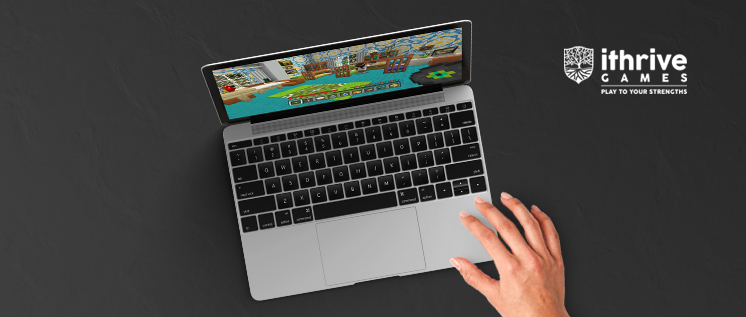
EDITOR'S NOTE: As teens head back to school, we're putting the focus on how one inventive and passionate educator makes commercial video games (as well as games of his own invention) a vibrant part of his teaching approach. Paul Darvasi teaches high school English at Royal St. George's Academy in Toronto, Canada.
***
I'm a high school teacher, game designer, and researcher who's experimented with a variety of digital and pervasive games in diverse instructional settings. If there's one thing I've learned after over a decade of teaching with digital games, it's that designing suitable contexts is essential for targeting learning outcomes. This especially applies to educators who want to integrate commercial off-the-shelf games (COTS) that were not deliberately produced for education. Take Civilization, for example, a sprawling turn-based history simulator that has made frequent appearances in classrooms. "Civ," as it's popularly known, starts at the dawn of time and, as the eons pass, players grow their empire as they carefully manage culture, technology, religion, economy, diplomacy, military, and political ideology. Even during informal play at home, players can't help but learn as they exercise strategic thinking, judicious resource allocation, and cost benefit analysis, to name a few skills requisite for imperial domination. But, when the game migrates to the classroom, standards and objectives can easily get lost amid the manifold demands of empire building. I love the idea of a class where one student incites sectarian violence in Cuzco, while another beefs up culture in St. Petersburg to rival Paris but, for better or worse, educators must rein in the action to achieve specific ends. Enter context.


Empire building in Civilization VI. Photo source.
Civilization's epic magnitude is not unusual by current video game standards. Players today expect to spend up to hundreds of hours immersed in digital worlds, so big studios bake in an impressive volume of choice-based, open world, and re-playable content. This can, of course, prove a tad overwhelming for a teacher looking to meet a specific outcome. There is also no guarantee that players will absorb the relevant learning material, as they often focus on efficiently beating the system at the expense of savoring narrative and/or information that isn't absolutely necessary to win the game. For example, every unit and concept in Civilization is linked to the "Civilopedia" that provides historically accurate background info; however, it's rare for a player caught-up in the frenzy of besieging a city to pause and read about the origins of the catapult in the third century B.C.
By strategically designing the right context, educators can remedy these issues and shepherd their charges to the glories of immersive learning unwittingly afforded by popular video games. Here are three key tactics to shape context to meet instructional goals:
Priming: This is a good way to foster socio-emotional responses, such as compassion, mindfulness, and empathy. Research has found that presenting relevant material prior to play can better sensitize players and foster awareness of emotional content. Using documentaries, articles, or narratives about the lived experiences of refugees to preface gameplay can lead to a more sensitive reception of refugee storylines in games like Skyrim, World of Warcraft, or Dragon Age: Origins. Similarly, reading testimonials about the challenges of LGBTQ youth may lead to a more nuanced reception of Gone Home or A Normal Lost Phone.
Ancillary Material: Curating accompanying material to support gameplay helps students hone in on learning objectives. Ancillary material can include readings, films, field trips, or lectures. I recently worked with a high school history teacher where we used Total War: Rome II to relay the idea that recorded history is necessarily grounded in perspective and bias. Although narrower in chronological scope than Civilization, Rome II is a complex Roman Empire strategy game with many moving parts. The history class's mini-unit concentrated on Caesar's first battle that launched his highly successful campaign in Gaul. Students read Caesar's own account of the battle in his autobiographical "The Gallic Wars," watched episode 12 of "The Conquerors," and had a hands-on Roman artifact workshop at the local museum. We projected the pertinent portion of the game on the big screen and students took turns playing it for two classes. It was all tied together with a culminating Harkness table discussion that addressed how each medium had its own unique affordances and constraints, and how each source omitted or added portions of the story. They not only absorbed a detailed account of a pivotal conflict, but clearly demonstrated a newly gained appreciation for the nuances of historical representation.
Supplementary material can be used before, during, and/or after gameplay.
Dialogue: I buy into a school of thought that proposes that knowledge is socially constructed, and that collaborative, dialogic approaches improve retention and better invest us in what we learn. Furnishing spaces for directed discussions, debates, and collaborative knowledge-building is an effective way to meet learning goals. These might include online forums, private Facebook groups, Socratic and Harkness table discussions, or small group mission-oriented task forces. Prompts, guiding questions, moderation, and artifacts can help keep the conversations on track. One of my favorite examples is Norwegian educator Tobias Staaby's use of The Walking Dead to teach moral philosophy. His students learn about diverse approaches to moral philosophy, and then enter the zombie apocalypse to field test their newfound knowledge. Staaby cues the game to a segment where the main character must make a difficult ethical decision. Before the choice is made, students break into small groups to determine their choice, which they must justify according to a specific branch of moral philosophy. Animated and informed discussion both preface and follow the decisive moment in the game.
Video games are highly malleable instruments and, as seen above, can be bent, repurposed, and reshaped to fit the lesson. Educators don't have to use the entire game, but can choose to play only what is applicable. Developers have created tools to modify games like Portal 2, Civilization, and Kerbal Space Program for users with little to no technical expertise, which has proven useful for the classroom. Also, if you don't have copies for every student or enough devices to go around, the games can be projected in front of the class and students can take turns playing, which can lead to a valuable shared experiences. In some cases, this "hotseat" format may be preferable even if budget and technology aren't barriers.
There are a growing number of existing lessons, mods, and teacher reviews available online for using video games and creating contexts, but more commercial game developers might also be wise to join the fray. By providing contextual educational material and lesson plans, along with affordable school licensing options, they would not only contribute to making education a better place, but also breathe new life into their product as it takes "just one more turn" at the market cycle.
***
